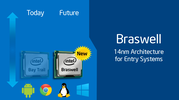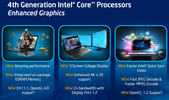Intel HD Graphics 400 (Braswell) vs Intel HD Graphics 4000 vs Intel HD Graphics 5000
Intel HD Graphics 400 (Braswell) ► remove from comparison
Die Intel HD Graphics 400 ist eine in den Low-End-SoCs der Braswell-Serie (z.B. Celeron Serie in 2016) integrierte Grafikeinheit. Sie basiert auf der gleichen Architektur wie die GPU verschiedener Broadwell-Prozessoren (z.B. HD Graphics 5300 ), bietet allerdings deutlich weniger Shadereinheiten und geringere Taktraten. Die genauen Spezifikationen hängen vom jeweiligen SoC ab: Die schnellste Variante bietet derzeit 12 EUs und maximal 640 MHz.
Anfangs wurde die GPU nur Intel HD Graphics benannt, später als Intel HD Graphics 400 (12 EU Version) und Intel HD Graphics 405 (16 EU Version) bezeichnet.
Anwender müssen sich deshalb insbesondere bei den Celeron-Modellen, die zusätzlich durch die Beschneidung auf nur zwei CPU-Kerne ausgebremst werden, auf ältere und anspruchslose Spiele beschränken. Videos werden dagegen auch in 4K/H.265 flüssig wiedergeben.
Für mehr Benchmarks besuchen sie auch die Seite der Intel HD Graphics (Braswell) GPU , welche Benchmarks der älteren baugleichen 12 und 16 EU Versionen beinhaltet.
Intel HD Graphics 4000 ► remove from comparison
Die Intel HD Graphics 4000 (GT2) ist eine Prozessorgrafikkarte in den CPUs der Ivy Bridge Generation (3. Generation von Intel Core z.B. Core i7-3770). Je nach Prozessormodell wird die Intel HD Graphics 4000 unterschiedlich getaktet (und kann auf den unterschiedlich großen Cache zurückgreifen) und bietet daher eine teilweise deutlich geringe Leistung. Weiterhin kann die Taktung durch die Turbo Boost Technologie je nach Anforderung und TDP deutlich erhöht werden. In den schnellen Modellen soll der Basistakt 650 MHz und der Turbo 1.1 bis 1.25 GHz betragen. Die ULV Modelle weisen jedoch einen deutlich geringeren Basistakt auf (Sandy Bridge z.B. 350 MHz).
Im Vergleich zur HD Graphics 3000 der Sandy Bridge Prozessoren, bietet die 4000er einen eigenen Cache, überarbeitete DirectX 11 taugliche Shader (und vier mehr) und soll dadurch bis zu 60% mehr Leistung (3DMark Vantage) zeigen. Weiterhin sollte die GPU auf den gemeinsamen Last Level Cache (Level 3 Cache) des Prozessors zugreifen können. Weiters können die Shader auch für Direct Compute genutzt werden.
Erste Benchmarks positionieren die HD Graphics 4000 (in einem schnellen Desktop Quad-Core) auf dem Level einer Nvidia GeForce GT 330M und dadurch oberhalb der integrierten Prozessorgrafik Radeon HD 6620G . In unserem Unfangreichen Testbericht der HD Graphics 4000 konnte sie sich im schnellen Core i7-3820QM deutlich durchsetzen (6620G 15% langsamer). In den Mittelklassemodellen Core i7-3610QM und einem Dual-Core i5 war sie nur noch knapp schneller. Manchmal ist sogar eine langsame GeForce GT 630M in Reichweite. Gelegenheitsspieler, die bei Bedarf mit einer geringen Auflösung, deaktivierter Kantenglättung und niedrigen Settings leben können, werden daher an der HD Graphics 4000 durchaus Gefallen finden. In den ULV Prozessoren (Core ix-3xx7U) wird eine geringer getaktete Variante eingesetzt. Durch die TDP Beschränkungen kann der Turbo außerdem meistens nicht so hoch takten, wie bei den 35/45 Watt Versionen. Dadurch ist die HD Graphics 4000 hier meist etwa 30% langsamer als in schnellen Quad-Core CPUs.
Eine Besonderheit der Ivy Bride Grafikkerne ist, das nur 4x MSAA von der Hardware unterstützt wird. 2x MSAA wird per Software berechnet und geht durch die 4x MSAA Pipeline. Daher empfiehlt sich der Einsatz des gleich schnellen 4x MSAA.
Auch der integrierte Videodecoder genannt Multi Format Codec Engine (MFX) wurde kräftig überarbeitet und soll nun sogar mehrere 4K Videos parallel dekodieren können (ev nur in den High-End Modellen). DXVA Checker gibt weiterhin die Formate MPEG2, VC1, WMV9 und H264 als unterstütz an. QuickSync zum schnellen Transkodieren von Videos wurde ebenfalls verbessert und soll nun schneller bei gleichzeitig höherer Qualität laufen.
Ebenfalls neu ist die Unterstützung für drei unabhängige Bildschirme (abhängig von der Umsetzung im Notebook eventuell nur zwei gleichzeitige möglich). Bis jetzt waren nur zwei möglich und lediglich die AMD Grafikkarten mit Eyefinity Support bieten mehr als zwei Anschlüsse für Notebooks (jedoch nur mit DisplayPorts). Laut Intel wird DisplayPort in der Version 1.1 unterstützt (daher maximal 2560x1600) und HDMI in 1.4 (in der Praxis 1920x1080, siehe Fokusartikel für 2560x1600 ).
Der Stromverbrauch ist dank des 22nm Prozesses mit 3D Tri-Gate Technologie relativ gering und nicht einzeln angegeben. Die Notebook-Prozessoren (CPU, GPU, Speichercontroller) sind gesamt auf einen TDP von 18-45 Watt spezifziert.
Intel HD Graphics 5000 ► remove from comparison
Die Intel HD Graphics 5000 (GT3) ist eine Prozessorgrafikkarte in den CPUs der Haswell- Generation. Zunächst wird die GPU in einigen ULV-Modellen mit 15 Watt TDP eingesetzt (z.B. Core i5-4250U ). Sie stellt die maximale Ausbaustufe der integrierten Grafikeinheit dar (40 Execution Units), muss im Gegensatz zur Iris Pro (GT3e) aber auf den zusätzlichen eDRAM-Cache verzichten. Abhängig von der Taktrate (diese fällt bei den 15-Watt-Modellen relativ niedrig aus) sowie der Hauptspeicheranbindung kann sich die Performance von Modell zu Modell leicht unterscheiden.
Der Grafikkern wurde im Vergleich zum Intel HD Graphics 4000 der Ivy-Bridge-Generation in verschiedenen Punkten weiterentwickelt. So unterstützt die GPU nun mit DirectX 11.1, OpenCL 1.2 und OpenGL 4.0 alle wichtigen aktuellen Standards. Auch ein verbesserter Decoder für 4K-Videos sowie ein überarbeiteter Quick-Sync-Encoder sind mit an Bord.
Die Performance der HD Graphics 5000 liegt im 3DMark 11 um etwa 50 Prozent oberhalb der HD 4000 der Vorgängergeneration. In Spielen fällt die Mehrleistung dagegen deutlich geringer aus: Bei gleichzeitiger Belastung der CPU kann die Grafikeinheit ihren starken Turbo-Boost nur sehr eingeschränkt ausschöpfen, da die niedrige TDP der ULV-Modelle (15 Watt) zu limitieren beginnt. Obwohl die HD 5000 mit 40 Execution Units (EUs) doppelt so viele Ausführungseinheiten wie die HD Graphics 4600 besitzt (HD 4000 : 16 EUs), ist die Grafikleistung darum dennoch etwas schwächer. Unterm Strich liegt die HD 5000 damit knapp hinter AMDs Radeon HD 7660G und auf dem Niveau einer dedizierte Radeon HD 7650M . Aktuelle 3D-Spiele (Stand 2013) können in niedrigen, seltener auch mittleren Einstellungen flüssig dargestellt werden.
Der Stromverbrauch ist dank des 22-Nanometer-Prozesses mit Tri-Gate-Transistoren relativ gering und wird dynamisch vom TDP-Budget des gesamten Chips abgezweigt. Die HD 5000 wird zunächst in einigen Dual-Core-Modellen der 15-Watt-Klasse (ULV) eingesetzt, beispielsweise dem Core i7-4650U .
Weitere Details zur Grafikkartenarchitektur der Haswell Generation finden Sie in unserem Artikel zur Vorstellung der Haswell-Generation .
Intel HD Graphics 400 (Braswell) Intel HD Graphics 4000 Intel HD Graphics 5000 HD Graphics Serie Codename Braswell Ivy Bridge Haswell GT3 Architektur Gen. 8 Gen. 7 Ivy Bridge Gen. 7.5 Haswell Pipelines 12 - unified 16 - unified 40 - unified Kerntakt 320 - 640 (Boost) MHz 350 - 1350 (Boost) MHz 200 - 1100 (Boost) MHz Speicherbandbreite 64/128 Bit 64/128 Bit 64/128 Bit Shared Memory ja ja ja API DirectX 11.2, Shader 5.0 DirectX 11, Shader 5.0, OpenGL 3.1 DirectX 11.1, Shader 5.0, OpenGL 4.0 Herstellungsprozess 14 nm 22 nm 22 nm Erscheinungsdatum 01.04.2016 23.03.2011 05.06.2013 Features QuickSync QuickSync
CPU in HD Graphics 400 (Braswell) GPU Base Speed GPU Boost / Turbo Intel Atom x5-Z8550 4 x 1440 MHz 200 MHz 600 MHz Intel Celeron N3060 2 x 1600 MHz, 6 W 320 MHz 700 MHz min. - max. 200 - 320 MHz 600 - 700 MHz
CPU in HD Graphics 4000 GPU Base Speed GPU Boost / Turbo Intel Core i7-3770K 4 x 3500 MHz, 77 W 650 MHz 1150 MHz Intel Core i7-3940XM 4 x 3000 MHz, 55 W 650 MHz 1350 MHz Intel Core i7-3920XM 4 x 2900 MHz, 55 W 650 MHz 1300 MHz » show 36 more Intel Core i7-3840QM 4 x 2800 MHz, 45 W 650 MHz 1300 MHz Intel Core i7-3820QM 4 x 2700 MHz, 45 W 650 MHz 1250 MHz Intel Core i7-3740QM 4 x 2700 MHz, 45 W 650 MHz 1300 MHz Intel Core i7-3720QM 4 x 2600 MHz, 45 W 650 MHz 1250 MHz Intel Core i5-3570K 4 x 3400 MHz, 77 W 650 MHz 1150 MHz Intel Core i7-3635QM 4 x 2400 MHz, 45 W 650 MHz 1200 MHz Intel Core i7-3630QM 4 x 2400 MHz, 45 W 650 MHz 1150 MHz Intel Core i7-3615QM 4 x 2300 MHz, 45 W 650 MHz 1200 MHz Intel Core i7-3610QM 4 x 2300 MHz, 45 W 650 MHz 1100 MHz Intel Core i7-3632QM 4 x 2200 MHz, 35 W 650 MHz 1150 MHz Intel Core i7-3612QM 4 x 2100 MHz, 35 W 650 MHz 1100 MHz Intel Core i7-3540M 2 x 3000 MHz, 35 W 650 MHz 1300 MHz Intel Core i7-3520M 2 x 2900 MHz, 35 W 650 MHz 1250 MHz Intel Core i5-3380M 2 x 2900 MHz, 35 W 650 MHz 1250 MHz Intel Core i5-3360M 2 x 2800 MHz, 35 W 650 MHz 1200 MHz Intel Core i5-3340M 2 x 2700 MHz, 35 W 650 MHz 1250 MHz Intel Core i5-3320M 2 x 2600 MHz, 35 W 650 MHz 1200 MHz Intel Core i5-3230M 2 x 2600 MHz, 35 W 650 MHz 1100 MHz Intel Core i7-3687U 2 x 2100 MHz, 17 W 350 MHz 1200 MHz Intel Core i5-3210M 2 x 2500 MHz, 35 W 650 MHz 1100 MHz Intel Core i7-3667U 2 x 2000 MHz, 17 W 350 MHz 1150 MHz Intel Core i7-3537U 2 x 2000 MHz, 17 W 350 MHz 1200 MHz Intel Core i7-3517U 2 x 1900 MHz, 17 W 350 MHz 1150 MHz Intel Core i3-3130M 2 x 2600 MHz, 35 W 650 MHz 1100 MHz Intel Core i5-3437U 2 x 1900 MHz, 17 W 650 MHz 1200 MHz Intel Core i3-3120M 2 x 2500 MHz, 35 W 650 MHz 1100 MHz Intel Core i5-3427U 2 x 1800 MHz, 17 W 350 MHz 1150 MHz Intel Core i5-3337U 2 x 1800 MHz, 17 W 350 MHz 1100 MHz Intel Core i3-3110M 2 x 2400 MHz, 35 W 650 MHz 1000 MHz Intel Core i5-3317U 2 x 1700 MHz, 17 W 350 MHz 1050 MHz Intel Core i7-3689Y 2 x 1500 MHz, 13 W 350 MHz 850 MHz Intel Core i5-3439Y 2 x 1500 MHz, 13 W 350 MHz 850 MHz Intel Core i3-3227U 2 x 1900 MHz, 17 W 350 MHz 1100 MHz Intel Core i5-3339Y 2 x 1500 MHz, 13 W 350 MHz 850 MHz Intel Core i3-3217U 2 x 1800 MHz, 17 W 350 MHz 1050 MHz Intel Core i3-3229Y 2 x 1400 MHz, 13 W 350 MHz 850 MHz min. - max. 200 - 650 MHz 600 - 1350 MHz
CPU in HD Graphics 5000 GPU Base Speed GPU Boost / Turbo Intel Core i7-4650U 2 x 1700 MHz, 15 W 200 MHz 1100 MHz Intel Core i7-4550U 2 x 1500 MHz, 15 W 200 MHz 1100 MHz Intel Core i5-4360U 2 x 1500 MHz, 15 W 200 MHz 1100 MHz » show 3 more Intel Core i5-4350U 2 x 1400 MHz, 15 W 200 MHz 1100 MHz Intel Core i5-4260U 2 x 1400 MHz, 15 W 200 MHz 1000 MHz Intel Core i5-4250U 2 x 1300 MHz, 15 W 200 MHz 1000 MHz min. - max. 200 - 650 MHz 600 - 1350 MHz
Benchmarks Performance Rating - 3DMark 11 + Fire Strike + Time Spy - HD Graphics 400 (Braswell)
0.1 pt (0%)
Intel HD Graphics 400 (Braswell)
...
max:
Performance Rating - 3DMark 11 + Fire Strike + Time Spy - HD Graphics 4000
0.2 pt (1%)
...
...
max:
Performance Rating - 3DMark 11 + Fire Strike + Time Spy - HD Graphics 5000
0.3 pt (1%)
...
...
max:
3DMark - 3DMark Ice Storm Unlimited Graphics
min: 17968 avg: 20459 median: 20277 (2%) max: 23161 Points
min: 43759 avg: 44324 median: 44323.5 (5%) max: 44888 Points
65904 Points (7%)
3DMark - 3DMark Ice Storm Extreme Graphics
14334 Points (2%)
min: 20514 avg: 24179 median: 24426 (3%) max: 28772 Points
37346 Points (5%)
3DMark - 3DMark Cloud Gate Score
min: 1350 avg: 1553 median: 1457 (2%) max: 2087 Points
min: 1469 avg: 3380 median: 3282.5 (4%) max: 5946 Points
min: 4331 avg: 4586 median: 4496.5 (5%) max: 5059 Points
3DMark - 3DMark Cloud Gate Graphics
min: 1519 avg: 1865 median: 1841 (0%) max: 2455 Points
min: 1619 avg: 3850 median: 3768.5 (1%) max: 5761 Points
min: 5381 avg: 5981 median: 5693.5 (1%) max: 6762 Points
3DMark - 3DMark Fire Strike Standard Score
min: 176 avg: 188 median: 188 (0%) max: 200 Points
min: 168 avg: 446.5 median: 444 (1%) max: 647 Points
min: 583 avg: 669 median: 651 (1%) max: 808 Points
3DMark - 3DMark Fire Strike Standard Graphics
min: 202 avg: 218 median: 218 (0%) max: 234 Points
min: 191 avg: 486.1 median: 480 (1%) max: 705 Points
min: 620 avg: 725 median: 715.5 (1%) max: 875 Points
3DMark - 3DMark Ice Storm Graphics
min: 13689 avg: 18517 median: 18516.5 (2%) max: 23344 Points
min: 11232 avg: 31858 median: 31598 (4%) max: 48923 Points
min: 35584 avg: 41867 median: 40454 (5%) max: 52302 Points
3DMark - 3DMark Sling Shot (ES 3.0) Unlimited
min: 1502 avg: 1926 median: 1925.5 (8%) max: 2349 Points
3DMark - 3DMark Sling Shot (ES 3.0) Unlimited Graphics
min: 1452 avg: 2046 median: 2046 (4%) max: 2640 Points
3DMark - 3DMark Sling Shot Extreme (ES 3.1) Unlimited
1180 Points (6%)
3DMark - 3DMark Sling Shot Extreme (ES 3.1) Unlimited Graphics
977 Points (3%)
3DMark 11 - 3DM11 Performance Score
min: 289 avg: 386.1 median: 397 (1%) max: 478 Points
min: 248 avg: 603 median: 603 (1%) max: 802 Points
min: 962 avg: 1088 median: 1125.5 (2%) max: 1163 Points
3DMark 11 - 3DM11 Performance GPU
min: 247 avg: 341.1 median: 349 (0%) max: 418 Points
min: 216 avg: 522 median: 523 (0%) max: 684 Points
min: 859 avg: 993 median: 1033.5 (1%) max: 1072 Points
3DMark Vantage + Intel HD Graphics 4000 3DMark Vantage - 3DM Vant. Perf. total
min: 830 avg: 2985 median: 2959 (1%) max: 4433 Points
3DM Vant. Perf. total + Intel HD Graphics 5000
min: 3418 avg: 4231 median: 4276.5 (1%) max: 4734 Points
3DM Vant. Perf. GPU no PhysX + Intel HD Graphics 4000 3DMark Vantage - 3DM Vant. Perf. GPU no PhysX
min: 659 avg: 2441 median: 2415 (1%) max: 3488 Points
3DM Vant. Perf. GPU no PhysX + Intel HD Graphics 5000
min: 2917 avg: 3639 median: 3665 (2%) max: 4108 Points
3DMark 2001SE - 3DMark 2001 - Standard
min: 8967 avg: 14343 median: 15220 (16%) max: 16933 Points
3DMark 03 - 3DMark 03 - Standard
min: 7402 avg: 11805 median: 12768 (7%) max: 19294 Points
min: 15752 avg: 18768 median: 18768 (10%) max: 21784 Points
3DMark 05 - 3DMark 05 - Standard
min: 5239 avg: 8296 median: 8393 (9%) max: 11948 Points
min: 9623 avg: 9763 median: 9763 (11%) max: 9903 Points
3DMark 06 3DMark 06 - Standard 1280x1024 + Intel HD Graphics 400 (Braswell)
2474 Points (3%)
3DMark 06 - Standard 1280x1024 + Intel HD Graphics 4000
min: 1605 avg: 4588 median: 4412.5 (6%) max: 7159 Points
3DMark 06 - Standard 1280x1024 + Intel HD Graphics 5000
min: 4751 avg: 5775 median: 5940 (8%) max: 6160 Points
3DMark 06 - Score Unknown Settings + Intel HD Graphics 4000
4276 Points (6%)
3DMark 06 - Standard 1280x800 + Intel HD Graphics 5000
6675 Points (9%)
Unigine Heaven 3.0 - Unigine Heaven 3.0 DX 11
min: 6.9 avg: 7.6 median: 7.4 (2%) max: 8.9 fps
12.1 fps (4%)
Unigine Heaven 3.0 - Unigine Heaven 3.0 OpenGL
min: 7.7 avg: 8.1 median: 8.1 (4%) max: 8.4 fps
12.1 fps (5%)
Unigine Heaven 2.1 - Heaven 2.1 high
min: 6 avg: 9.6 median: 9.4 (2%) max: 13 fps
min: 12.3 avg: 13 median: 13.1 (2%) max: 13.5 fps
SPECviewperf 11 + Intel HD Graphics 4000 SPECviewperf 11 - specvp11 snx-01
min: 0.69 avg: 1.1 median: 1.2 (1%) max: 1.47 fps
specvp11 snx-01 + Intel HD Graphics 5000
min: 1.26 avg: 1.5 median: 1.5 (1%) max: 1.64 fps
specvp11 tcvis-02 + Intel HD Graphics 4000 SPECviewperf 11 - specvp11 tcvis-02
min: 1.43 avg: 1.9 median: 2.1 (1%) max: 2.27 fps
specvp11 tcvis-02 + Intel HD Graphics 5000
min: 1.77 avg: 2.1 median: 2.1 (1%) max: 2.51 fps
specvp11 sw-02 + Intel HD Graphics 4000 SPECviewperf 11 - specvp11 sw-02
min: 3.98 avg: 6.9 median: 7.5 (6%) max: 8.45 fps
specvp11 sw-02 + Intel HD Graphics 5000
min: 7.95 avg: 9.9 median: 9.9 (8%) max: 11.8 fps
specvp11 proe-05 + Intel HD Graphics 4000 SPECviewperf 11 - specvp11 proe-05
min: 0.62 avg: 1.1 median: 1.2 (1%) max: 1.47 fps
specvp11 proe-05 + Intel HD Graphics 5000
min: 1.42 avg: 1.6 median: 1.6 (2%) max: 1.78 fps
specvp11 maya-03 + Intel HD Graphics 4000 SPECviewperf 11 - specvp11 maya-03
min: 7.12 avg: 10.2 median: 9.7 (7%) max: 13.09 fps
specvp11 maya-03 + Intel HD Graphics 5000
min: 12.95 avg: 14.2 median: 14.2 (11%) max: 15.43 fps
specvp11 lightwave-01 + Intel HD Graphics 4000 SPECviewperf 11 - specvp11 lightwave-01
min: 5.67 avg: 10.2 median: 11.1 (12%) max: 12.55 fps
specvp11 lightwave-01 + Intel HD Graphics 5000
min: 13.34 avg: 14.5 median: 14.5 (16%) max: 15.62 fps
specvp11 ensight-04 + Intel HD Graphics 4000 SPECviewperf 11 - specvp11 ensight-04
min: 1.06 avg: 1.6 median: 1.7 (1%) max: 2.24 fps
specvp11 ensight-04 + Intel HD Graphics 5000
min: 2.06 avg: 2.1 median: 2.1 (1%) max: 2.11 fps
specvp11 catia-03 + Intel HD Graphics 4000 SPECviewperf 11 - specvp11 catia-03
0 fps (0%)
specvp11 catia-03 + Intel HD Graphics 5000
4.5 fps (2%)
Windows 7 Experience Index - Win7 Gaming graphics
min: 5.9 avg: 6.4 median: 6.4 (81%) max: 6.6 Points
min: 6.5 avg: 6.6 median: 6.6 (84%) max: 6.7 Points
Windows 7 Experience Index - Win7 Graphics
min: 4.7 avg: 5.6 median: 5.1 (65%) max: 6.6 Points
min: 5.8 avg: 5.9 median: 5.9 (74%) max: 5.9 Points
Cinebench R10 Cinebench R10 Shading (32bit) + Intel HD Graphics 400 (Braswell) Cinebench R10 - Cinebench R10 Shading (32bit)
min: 1627 avg: 2057 median: 2052.5 (1%) max: 2510 Points
Cinebench R10 Shading (32bit) + Intel HD Graphics 4000
min: 2447 avg: 5020 median: 5157 (4%) max: 8562 Points
Cinebench R10 Shading (32bit) + Intel HD Graphics 5000
min: 5143 avg: 6901 median: 6946.5 (5%) max: 7959 Points
Cinebench R11.5 Cinebench R11.5 OpenGL 64 Bit + Intel HD Graphics 400 (Braswell) Cinebench R11.5 - Cinebench R11.5 OpenGL 64 Bit
min: 9.97 avg: 10.1 median: 10 (3%) max: 10.12 fps
Cinebench R11.5 OpenGL 64 Bit + Intel HD Graphics 4000
min: 5.58 avg: 14.4 median: 13.6 (5%) max: 22.54 fps
Cinebench R11.5 OpenGL 64 Bit + Intel HD Graphics 5000
min: 15.01 avg: 19.6 median: 19.6 (7%) max: 24.76 fps
Cinebench R15 + Intel HD Graphics 400 (Braswell) Cinebench R15 - Cinebench R15 OpenGL 64 Bit
min: 8.48 avg: 11 median: 11.3 (1%) max: 13.98 fps
Cinebench R15 OpenGL 64 Bit + Intel HD Graphics 4000
min: 8.47 avg: 11.9 median: 11.9 (1%) max: 15.35 fps
Cinebench R15 OpenGL 64 Bit + Intel HD Graphics 5000
min: 24.15 avg: 27.4 median: 27.4 (2%) max: 30.64 fps
Cinebench R15 OpenGL Ref. Match 64 Bit + Intel HD Graphics 400 (Braswell) Cinebench R15 - Cinebench R15 OpenGL Ref. Match 64 Bit
98 % (98%)
Cinebench R15 OpenGL Ref. Match 64 Bit + Intel HD Graphics 4000
min: 32.2 avg: 50.9 median: 32.2 (32%) max: 97.8 %
Cinebench R15 OpenGL Ref. Match 64 Bit + Intel HD Graphics 5000
min: 63.3 avg: 81.1 median: 80.7 (81%) max: 99.6 %
GFXBench - GFXBench 5.0 Aztec Ruins High Tier Offscreen
3.3 fps (1%)
GFXBench - GFXBench 5.0 Aztec Ruins Normal Tier Offscreen
9.3 fps (1%)
GFXBench 3.1 - GFXBench Manhattan ES 3.1 Offscreen
min: 7.2 avg: 10.6 median: 10.6 (0%) max: 14 fps
GFXBench 3.0 - GFXBench 3.0 Manhattan Offscreen
min: 14 avg: 16 median: 16 (1%) max: 18 fps
22.5 fps (1%)
GFXBench (DX / GLBenchmark) 2.7 + Intel HD Graphics 400 (Braswell) GFXBench (DX / GLBenchmark) 2.7 - GFXBench T-Rex HD Offscreen C24Z16
min: 27 avg: 29 median: 29 (0%) max: 31 fps
GFXBench T-Rex HD Offscreen C24Z16 + Intel HD Graphics 4000 min: 31 avg: 40.1 median: 39 (0%) max: 49 fps
GFXBench T-Rex HD Offscreen C24Z16 + Intel HD Graphics 5000
min: 62 avg: 72.5 median: 72.5 (1%) max: 83 fps
LuxMark v2.0 64Bit - LuxMark v2.0 Room GPU
min: 31 avg: 46.9 median: 34 (0%) max: 163 Samples/s
min: 139 avg: 187 median: 201 (1%) max: 221 Samples/s
LuxMark v2.0 64Bit - LuxMark v2.0 Sala GPU
min: 50 avg: 79.4 median: 66 (0%) max: 251 Samples/s
min: 286 avg: 305.3 median: 306 (1%) max: 324 Samples/s
ComputeMark v2.1 - ComputeMark v2.1 Result
min: 31 avg: 514 median: 537 (1%) max: 630 Points
min: 775 avg: 817 median: 816.5 (1%) max: 858 Points
Average Benchmarks Intel HD Graphics 400 (Braswell) → 100% n=15 Average Benchmarks Intel HD Graphics 4000 → 172% n=15 Average Benchmarks Intel HD Graphics 5000 → 268% n=15
- Bereich der Benchmarkergebnisse für diese Grafikkarte
- Durchschnittliche Benchmarkergebnisse für diese Grafikkarte
* Smaller numbers mean a higher performance
1 This benchmark is not used for the average calculation
Spiele-Benchmarks Die folgenden Benchmarks basieren auf unseren Spieletests mit Testnotebooks. Die Performance dieser Grafikkarte bei den gelisteten Spielen ist abhängig von der verwendeten CPU, Speicherausstattung, Treiber und auch Betriebssystem. Dadurch müssen die untenstehenden Werte nicht repräsentativ sein. Detaillierte Informationen über das verwendete System sehen Sie nach einem Klick auf den fps-Wert.
100%
HD Graphics 400 (Braswell):
14.1 fps
100%
HD Graphics 400 (Braswell):
18.5 fps
368%
HD Graphics 4000:
68 [X] Asus N56VM Intel Core i7-3720QM 2.6GHz
HD Graphics 4000
min:
63 fps
fps
100%
HD Graphics 400 (Braswell):
16 fps
HD Graphics 4000:
13.3 [X] Asus N56VM Intel Core i7-3720QM 2.6GHz
HD Graphics 4000
fps
100%
HD Graphics 400 (Braswell):
12.7 fps
100%
HD Graphics 400 (Braswell):
6.8 fps
100%
HD Graphics 400 (Braswell):
10.7 fps
100%
HD Graphics 400 (Braswell):
20.9 fps
206%
HD Graphics 4000:
43 [X] Asus N56VM Intel Core i7-3720QM 2.6GHz
HD Graphics 4000
min:
39 fps, max:
51 fps
fps
100%
HD Graphics 400 (Braswell):
5.8 fps
433%
HD Graphics 4000:
25.1 [X] Asus N56VM Intel Core i7-3720QM 2.6GHz
HD Graphics 4000
min:
23 fps, max:
30 fps
fps
100%
HD Graphics 400 (Braswell):
9.7 fps
HD Graphics 4000:
0 (!) [X] Asus N56VM Intel Core i7-3720QM 2.6GHz
HD Graphics 4000
fps
100%
HD Graphics 400 (Braswell):
15 15.1 ~ 15 fps
171%
HD Graphics 4000:
25.6 [X] Asus N56VM Intel Core i7-3720QM 2.6GHz
HD Graphics 4000
min:
19 fps, max:
31 fps
fps
100%
HD Graphics 400 (Braswell):
9.5 9.7 ~ 10 fps
100%
HD Graphics 400 (Braswell):
5.3 fps
189%
HD Graphics 4000:
10 [X] Asus N56VM Intel Core i7-3720QM 2.6GHz
HD Graphics 4000
min:
9 fps, max:
11 fps
fps
100%
HD Graphics 400 (Braswell):
7.3 fps
100%
HD Graphics 400 (Braswell):
3.2 fps
100%
HD Graphics 400 (Braswell):
36.5 fps
164%
HD Graphics 4000:
60 [X] Asus N56VM Intel Core i7-3720QM 2.6GHz
HD Graphics 4000
min:
53 fps, max:
62 fps
fps
100%
HD Graphics 400 (Braswell):
14.2 fps
183%
HD Graphics 4000:
26 [X] Asus N56VM Intel Core i7-3720QM 2.6GHz
HD Graphics 4000
min:
23 fps, max:
30 fps
fps
100%
HD Graphics 400 (Braswell):
9 fps
178%
HD Graphics 4000:
16 [X] Asus N56VM Intel Core i7-3720QM 2.6GHz
HD Graphics 4000
min:
13 fps, max:
18 fps
fps
100%
HD Graphics 400 (Braswell):
13 fps
436%
HD Graphics 4000:
56.7 [X] Asus N56VM Intel Core i7-3720QM 2.6GHz
HD Graphics 4000
min:
44 fps, max:
71 fps
fps
100%
HD Graphics 400 (Braswell):
8 fps
450%
HD Graphics 4000:
36 [X] Asus N56VM Intel Core i7-3720QM 2.6GHz
HD Graphics 4000
min:
25 fps, max:
48 fps
fps
HD Graphics 4000:
17.1 [X] Asus N56VM Intel Core i7-3720QM 2.6GHz
HD Graphics 4000
min:
11 fps, max:
26 fps
fps
HD Graphics 4000:
12.4 [X] Asus N56VM Intel Core i7-3720QM 2.6GHz
HD Graphics 4000
min:
7 fps, max:
20 fps
fps
100%
HD Graphics 400 (Braswell):
13.3 fps
308%
HD Graphics 4000:
41 [X] Asus N56VM Intel Core i7-3720QM 2.6GHz
HD Graphics 4000
min:
37 fps, max:
45 fps
fps
HD Graphics 4000:
25.2 [X] Asus N56VM Intel Core i7-3720QM 2.6GHz
HD Graphics 4000
min:
24 fps, max:
27 fps
fps
HD Graphics 4000:
9.6 [X] Asus N56VM Intel Core i7-3720QM 2.6GHz
HD Graphics 4000
min:
7 fps, max:
12 fps
fps
HD Graphics 4000:
14.6 [X] Asus N56VM Intel Core i7-3720QM 2.6GHz
HD Graphics 4000
min:
8 fps, max:
20 fps
fps
100%
HD Graphics 400 (Braswell):
21.3 fps
451%
HD Graphics 4000:
96 [X] Asus N56VM Intel Core i7-3720QM 2.6GHz
HD Graphics 4000
min:
81 fps
fps
100%
HD Graphics 400 (Braswell):
11.4 fps
353%
HD Graphics 4000:
40.2 [X] Asus N56VM Intel Core i7-3720QM 2.6GHz
HD Graphics 4000
min:
36 fps
fps
HD Graphics 4000:
16.9 [X] Asus N56VM Intel Core i7-3720QM 2.6GHz
HD Graphics 4000
min:
14 fps
fps
100%
HD Graphics 400 (Braswell):
8.5 fps
100%
HD Graphics 400 (Braswell):
5.6 fps
100%
HD Graphics 400 (Braswell):
40.1 fps
180%
HD Graphics 4000:
53.7 91 (!) [X] Asus N56VM Intel Core i7-3720QM 2.6GHz
HD Graphics 4000
min:
66 fps, max:
128 fps
~ 72 fps
100%
HD Graphics 400 (Braswell):
11.7 fps
162%
HD Graphics 4000:
16.4 21 [X] Asus N56VM Intel Core i7-3720QM 2.6GHz
HD Graphics 4000
min:
15 fps, max:
27 fps
~ 19 fps
HD Graphics 4000:
12.5 12.6 [X] Asus N56VM Intel Core i7-3720QM 2.6GHz
HD Graphics 4000
min:
12.5 fps, max:
15.2 fps
~ 13 fps
HD Graphics 4000:
12.5 fps
100%
HD Graphics 400 (Braswell):
14.3 fps
187%
HD Graphics 4000:
26.8 [X] Asus N56VM Intel Core i7-3720QM 2.6GHz
HD Graphics 4000
min:
5 fps, max:
81 fps
fps
134%
HD Graphics 5000:
19.2 fps
HD Graphics 4000:
21.2 [X] Asus N56VM Intel Core i7-3720QM 2.6GHz
HD Graphics 4000
min:
10 fps, max:
33 fps
fps
HD Graphics 5000:
20.8 fps
HD Graphics 5000:
15.1 fps
HD Graphics 4000:
12.2 [X] Asus N56VM Intel Core i7-3720QM 2.6GHz
HD Graphics 4000
min:
9 fps, max:
16 fps
fps
HD Graphics 5000:
12.7 fps
HD Graphics 4000:
15 [X] Asus N56VM Intel Core i7-3720QM 2.6GHz
HD Graphics 4000
min:
6 fps, max:
25 fps
fps
HD Graphics 5000:
15.8 fps
HD Graphics 5000:
10.6 fps
100%
HD Graphics 400 (Braswell):
5.4 fps
343%
HD Graphics 4000:
18.5 [X] Asus N56VM Intel Core i7-3720QM 2.6GHz
HD Graphics 4000
min:
14 fps
fps
322%
HD Graphics 5000:
17.4 fps
100%
HD Graphics 400 (Braswell):
2.9 fps
403%
HD Graphics 4000:
11.7 [X] Asus N56VM Intel Core i7-3720QM 2.6GHz
HD Graphics 4000
min:
9 fps
fps
414%
HD Graphics 5000:
12 fps
HD Graphics 4000:
13.2 [X] Asus N56VM Intel Core i7-3720QM 2.6GHz
HD Graphics 4000
min:
2 fps, max:
24 fps
fps
HD Graphics 5000:
14.3 fps
HD Graphics 5000:
10.6 fps
HD Graphics 4000:
3 (!) [X] Asus N56VM Intel Core i7-3720QM 2.6GHz
HD Graphics 4000
fps
HD Graphics 4000:
0 (!) [X] Asus N56VM Intel Core i7-3720QM 2.6GHz
HD Graphics 4000
fps
HD Graphics 5000:
25.4 fps
HD Graphics 5000:
16.2 fps
HD Graphics 4000:
18.2 [X] Asus N56VM Intel Core i7-3720QM 2.6GHz
HD Graphics 4000
min:
4 fps, max:
100 fps
fps
HD Graphics 5000:
15.5 fps
HD Graphics 4000:
8.1 [X] Asus N56VM Intel Core i7-3720QM 2.6GHz
HD Graphics 4000
min:
2 fps, max:
73 fps
fps
HD Graphics 5000:
12.2 fps
100%
HD Graphics 400 (Braswell):
27 fps
174%
HD Graphics 4000:
38 55 [X] Asus N56VM Intel Core i7-3720QM 2.6GHz
HD Graphics 4000
min:
26 fps
~ 47 fps
189%
HD Graphics 5000:
51 fps
100%
HD Graphics 400 (Braswell):
16 fps
175%
HD Graphics 4000:
23 33 [X] Asus N56VM Intel Core i7-3720QM 2.6GHz
HD Graphics 4000
min:
16 fps
~ 28 fps
219%
HD Graphics 5000:
35 fps
HD Graphics 4000:
16 18 [X] Asus N56VM Intel Core i7-3720QM 2.6GHz
HD Graphics 4000
min:
12 fps
~ 17 fps
HD Graphics 4000:
12 [X] Asus N56VM Intel Core i7-3720QM 2.6GHz
HD Graphics 4000
min:
12 fps
12.5 ~ 12 fps
HD Graphics 4000:
8.8 [X] Asus N56VM Intel Core i7-3720QM 2.6GHz
HD Graphics 4000
max:
18 fps
fps
HD Graphics 5000:
14.2 fps
HD Graphics 5000:
10.6 fps
HD Graphics 4000:
11.4 [X] Asus N56VM Intel Core i7-3720QM 2.6GHz
HD Graphics 4000
min:
1 fps, max:
18 fps
fps
HD Graphics 5000:
14.7 fps
100%
HD Graphics 400 (Braswell):
11.5 11.9 ~ 12 fps
238%
HD Graphics 4000:
28.6 [X] Asus N56VM Intel Core i7-3720QM 2.6GHz
HD Graphics 4000
fps
241%
HD Graphics 5000:
28.9 fps
100%
HD Graphics 400 (Braswell):
7 fps
260%
HD Graphics 4000:
18.2 [X] Asus N56VM Intel Core i7-3720QM 2.6GHz
HD Graphics 4000
fps
299%
HD Graphics 5000:
20.9 fps
HD Graphics 5000:
11.4 fps
HD Graphics 4000:
13 [X] Asus N56VM Intel Core i7-3720QM 2.6GHz
HD Graphics 4000
min:
8 fps
fps
HD Graphics 5000:
20.1 fps
HD Graphics 4000:
32.4 [X] Asus N56VM Intel Core i7-3720QM 2.6GHz
HD Graphics 4000
min:
24 fps, max:
42 fps
fps
HD Graphics 5000:
36.2 fps
HD Graphics 4000:
24.6 [X] Asus N56VM Intel Core i7-3720QM 2.6GHz
HD Graphics 4000
min:
19 fps, max:
30 fps
fps
HD Graphics 5000:
28.1 fps
HD Graphics 4000:
15.7 [X] Asus N56VM Intel Core i7-3720QM 2.6GHz
HD Graphics 4000
min:
12 fps, max:
19 fps
fps
HD Graphics 5000:
17.4 fps
100%
HD Graphics 400 (Braswell):
37 fps
455%
HD Graphics 5000:
168.3 fps
100%
HD Graphics 400 (Braswell):
7.6 fps
432%
HD Graphics 5000:
32.8 fps
HD Graphics 5000:
14.2 fps
100%
HD Graphics 400 (Braswell):
6.5 fps
560%
HD Graphics 4000:
36.4 [X] Asus N56VM Intel Core i7-3720QM 2.6GHz
HD Graphics 4000
min:
24 fps, max:
43 fps
fps
442%
HD Graphics 5000:
28.7 fps
100%
HD Graphics 400 (Braswell):
4.8 fps
367%
HD Graphics 4000:
17.6 [X] Asus N56VM Intel Core i7-3720QM 2.6GHz
HD Graphics 4000
min:
9 fps, max:
22 fps
fps
367%
HD Graphics 5000:
17.6 fps
HD Graphics 4000:
7.2 [X] Asus N56VM Intel Core i7-3720QM 2.6GHz
HD Graphics 4000
min:
5 fps, max:
9 fps
fps
100%
HD Graphics 400 (Braswell):
28.9 fps
287%
HD Graphics 4000:
83 [X] Asus N56VM Intel Core i7-3720QM 2.6GHz
HD Graphics 4000
min:
46 fps, max:
137 fps
fps
297%
HD Graphics 5000:
85.7 fps
100%
HD Graphics 400 (Braswell):
12.5 fps
200%
HD Graphics 4000:
25 [X] Asus N56VM Intel Core i7-3720QM 2.6GHz
HD Graphics 4000
min:
14 fps, max:
42 fps
fps
242%
HD Graphics 5000:
30.2 fps
HD Graphics 4000:
14 [X] Asus N56VM Intel Core i7-3720QM 2.6GHz
HD Graphics 4000
fps
HD Graphics 5000:
14.9 fps
HD Graphics 5000:
12.5 fps
HD Graphics 4000:
12.7 [X] Asus N56VM Intel Core i7-3720QM 2.6GHz
HD Graphics 4000
max:
26 fps
fps
HD Graphics 5000:
17 18.1 ~ 18 fps
HD Graphics 4000:
31 [X] Asus N56VM Intel Core i7-3720QM 2.6GHz
HD Graphics 4000
min:
15 fps, max:
47 fps
fps
HD Graphics 5000:
27.2 fps
HD Graphics 4000:
21.9 [X] Asus N56VM Intel Core i7-3720QM 2.6GHz
HD Graphics 4000
min:
6 fps, max:
46 fps
fps
HD Graphics 5000:
22.1 fps
HD Graphics 4000:
9.1 [X] Asus N56VM Intel Core i7-3720QM 2.6GHz
HD Graphics 4000
max:
15 fps
fps
HD Graphics 5000:
10.7 fps
HD Graphics 4000:
40 [X] Asus N56VM Intel Core i7-3720QM 2.6GHz
HD Graphics 4000
min:
26 fps, max:
60 fps
fps
HD Graphics 4000:
23.1 [X] Asus N56VM Intel Core i7-3720QM 2.6GHz
HD Graphics 4000
min:
17 fps, max:
32 fps
fps
HD Graphics 4000:
13.9 [X] Asus N56VM Intel Core i7-3720QM 2.6GHz
HD Graphics 4000
min:
9 fps, max:
19 fps
fps
HD Graphics 4000:
7.2 [X] Asus N56VM Intel Core i7-3720QM 2.6GHz
HD Graphics 4000
min:
3 fps, max:
11 fps
fps
HD Graphics 4000:
20.4 [X] Schenker XMG P502 Intel Core i7-3610QM 2.3GHz
HD Graphics 4000
fps
HD Graphics 5000:
33.2 fps
HD Graphics 4000:
10.9 [X] Schenker XMG P502 Intel Core i7-3610QM 2.3GHz
HD Graphics 4000
fps
HD Graphics 5000:
20.2 fps
HD Graphics 4000:
6.7 [X] Schenker XMG P502 Intel Core i7-3610QM 2.3GHz
HD Graphics 4000
fps
HD Graphics 5000:
13.2 fps
HD Graphics 4000:
4.9 [X] Schenker XMG P502 Intel Core i7-3610QM 2.3GHz
HD Graphics 4000
fps
HD Graphics 4000:
19 [X] Schenker XMG P502 Intel Core i7-3610QM 2.3GHz
HD Graphics 4000
fps
HD Graphics 4000:
10.9 [X] Schenker XMG P502 Intel Core i7-3610QM 2.3GHz
HD Graphics 4000
fps
HD Graphics 5000:
8.4 9.7 ~ 9 fps
HD Graphics 4000:
8.8 [X] Schenker XMG P502 Intel Core i7-3610QM 2.3GHz
HD Graphics 4000
fps
HD Graphics 4000:
4.3 [X] Schenker XMG P502 Intel Core i7-3610QM 2.3GHz
HD Graphics 4000
fps
HD Graphics 4000:
23.6 [X] Schenker XMG P502 Intel Core i7-3610QM 2.3GHz
HD Graphics 4000
fps
HD Graphics 4000:
17.4 [X] Schenker XMG P502 Intel Core i7-3610QM 2.3GHz
HD Graphics 4000
fps
HD Graphics 4000:
7.4 [X] Schenker XMG P502 Intel Core i7-3610QM 2.3GHz
HD Graphics 4000
fps
HD Graphics 4000:
3.6 [X] Schenker XMG P502 Intel Core i7-3610QM 2.3GHz
HD Graphics 4000
fps
100%
HD Graphics 400 (Braswell):
11.8 fps
356%
HD Graphics 4000:
37.7 [X] Asus N56VM Intel Core i7-3720QM 2.6GHz
HD Graphics 4000
46 [X] Schenker XMG P502 Intel Core i7-3610QM 2.3GHz
HD Graphics 4000
~ 42 fps
HD Graphics 4000:
14.6 [X] Asus N56VM Intel Core i7-3720QM 2.6GHz
HD Graphics 4000
18.1 [X] Schenker XMG P502 Intel Core i7-3610QM 2.3GHz
HD Graphics 4000
~ 16 fps
HD Graphics 4000:
6.6 [X] Asus N56VM Intel Core i7-3720QM 2.6GHz
HD Graphics 4000
7.4 [X] Schenker XMG P502 Intel Core i7-3610QM 2.3GHz
HD Graphics 4000
~ 7 fps
HD Graphics 4000:
4.4 [X] Asus N56VM Intel Core i7-3720QM 2.6GHz
HD Graphics 4000
4.7 [X] Schenker XMG P502 Intel Core i7-3610QM 2.3GHz
HD Graphics 4000
~ 5 fps
HD Graphics 4000:
12.6 [X] Asus N56VM Intel Core i7-3720QM 2.6GHz
HD Graphics 4000
min:
5 fps, max:
27 fps
fps
HD Graphics 4000:
40.6 [X] Schenker XMG P502 Intel Core i7-3610QM 2.3GHz
HD Graphics 4000
fps
HD Graphics 4000:
24.3 [X] Schenker XMG P502 Intel Core i7-3610QM 2.3GHz
HD Graphics 4000
fps
HD Graphics 5000:
20.5 fps
HD Graphics 4000:
7.2 [X] Schenker XMG P502 Intel Core i7-3610QM 2.3GHz
HD Graphics 4000
fps
HD Graphics 4000:
4 [X] Schenker XMG P502 Intel Core i7-3610QM 2.3GHz
HD Graphics 4000
fps
100%
HD Graphics 400 (Braswell):
16.2 fps
199%
HD Graphics 4000:
32.2 [X] Schenker XMG P502 Intel Core i7-3610QM 2.3GHz
HD Graphics 4000
fps
177%
HD Graphics 5000:
28.6 fps
100%
HD Graphics 400 (Braswell):
12.3 fps
160%
HD Graphics 4000:
19.7 [X] Schenker XMG P502 Intel Core i7-3610QM 2.3GHz
HD Graphics 4000
fps
162%
HD Graphics 5000:
19.9 fps
100%
HD Graphics 400 (Braswell):
7.9 fps
154%
HD Graphics 4000:
12.2 [X] Schenker XMG P502 Intel Core i7-3610QM 2.3GHz
HD Graphics 4000
fps
168%
HD Graphics 5000:
13.3 fps
HD Graphics 4000:
4.7 [X] Schenker XMG P502 Intel Core i7-3610QM 2.3GHz
HD Graphics 4000
fps
HD Graphics 4000:
52 [X] Schenker XMG P502 Intel Core i7-3610QM 2.3GHz
HD Graphics 4000
fps
HD Graphics 4000:
30 [X] Schenker XMG P502 Intel Core i7-3610QM 2.3GHz
HD Graphics 4000
fps
HD Graphics 4000:
12 [X] Schenker XMG P502 Intel Core i7-3610QM 2.3GHz
HD Graphics 4000
fps
HD Graphics 4000:
6 [X] Schenker XMG P502 Intel Core i7-3610QM 2.3GHz
HD Graphics 4000
fps
100%
HD Graphics 400 (Braswell):
30 fps
100%
HD Graphics 400 (Braswell):
28 fps
196%
HD Graphics 4000:
34 34 48 76 [X] Asus N56VM Intel Core i7-3720QM 2.6GHz
HD Graphics 4000
85 [X] Schenker XMG P502 Intel Core i7-3610QM 2.3GHz
HD Graphics 4000
~ 55 fps
182%
HD Graphics 5000:
51 fps
100%
HD Graphics 400 (Braswell):
17 fps
200%
HD Graphics 4000:
28 28 33 46 [X] Schenker XMG P502 Intel Core i7-3610QM 2.3GHz
HD Graphics 4000
~ 34 fps
200%
HD Graphics 5000:
34 fps
HD Graphics 4000:
24 25 26 33 [X] Schenker XMG P502 Intel Core i7-3610QM 2.3GHz
HD Graphics 4000
~ 27 fps
HD Graphics 4000:
12 [X] Schenker XMG P502 Intel Core i7-3610QM 2.3GHz
HD Graphics 4000
12 12 ~ 12 fps
HD Graphics 4000:
87.1 [X] Samsung 740U3E-A01UB Intel Core i5-3337U 1.8GHz
HD Graphics 4000
182 207.4 [X] Schenker XMG P502 Intel Core i7-3610QM 2.3GHz
HD Graphics 4000
~ 159 fps
HD Graphics 5000:
165.1 fps
HD Graphics 4000:
56.7 [X] Samsung 740U3E-A01UB Intel Core i5-3337U 1.8GHz
HD Graphics 4000
97 112.1 [X] Schenker XMG P502 Intel Core i7-3610QM 2.3GHz
HD Graphics 4000
~ 89 fps
HD Graphics 5000:
100.2 fps
HD Graphics 4000:
33.7 [X] Samsung 740U3E-A01UB Intel Core i5-3337U 1.8GHz
HD Graphics 4000
48 84 [X] Asus N56VM Intel Core i7-3720QM 2.6GHz
HD Graphics 4000
85.4 [X] Schenker XMG P502 Intel Core i7-3610QM 2.3GHz
HD Graphics 4000
~ 63 fps
HD Graphics 5000:
71.4 fps
HD Graphics 4000:
18 [X] Samsung 740U3E-A01UB Intel Core i5-3337U 1.8GHz
HD Graphics 4000
26 44.7 [X] Schenker XMG P502 Intel Core i7-3610QM 2.3GHz
HD Graphics 4000
49.6 [X] Asus N56VM Intel Core i7-3720QM 2.6GHz
HD Graphics 4000
~ 35 fps
HD Graphics 5000:
39.3 fps
HD Graphics 4000:
20 25.6 29.9 42 [X] Schenker XMG P502 Intel Core i7-3610QM 2.3GHz
HD Graphics 4000
~ 29 fps
HD Graphics 5000:
39.8 fps
HD Graphics 4000:
14 19.4 21.6 30.9 [X] Schenker XMG P502 Intel Core i7-3610QM 2.3GHz
HD Graphics 4000
~ 21 fps
HD Graphics 5000:
29.4 fps
HD Graphics 5000:
21.6 fps
HD Graphics 4000:
28.6 [X] Asus N56VM Intel Core i7-3720QM 2.6GHz
HD Graphics 4000
30.8 [X] Schenker XMG P502 Intel Core i7-3610QM 2.3GHz
HD Graphics 4000
~ 30 fps
HD Graphics 4000:
20.6 [X] Schenker XMG P502 Intel Core i7-3610QM 2.3GHz
HD Graphics 4000
21.8 [X] Asus N56VM Intel Core i7-3720QM 2.6GHz
HD Graphics 4000
~ 21 fps
HD Graphics 4000:
9.4 [X] Schenker XMG P502 Intel Core i7-3610QM 2.3GHz
HD Graphics 4000
9.6 [X] Asus N56VM Intel Core i7-3720QM 2.6GHz
HD Graphics 4000
~ 10 fps
HD Graphics 4000:
5.5 [X] Schenker XMG P502 Intel Core i7-3610QM 2.3GHz
HD Graphics 4000
5.5 [X] Asus N56VM Intel Core i7-3720QM 2.6GHz
HD Graphics 4000
~ 6 fps
HD Graphics 4000:
38.2 [X] Schenker XMG P502 Intel Core i7-3610QM 2.3GHz
HD Graphics 4000
fps
HD Graphics 4000:
16.4 [X] Schenker XMG P502 Intel Core i7-3610QM 2.3GHz
HD Graphics 4000
fps
HD Graphics 4000:
8.9 [X] Schenker XMG P502 Intel Core i7-3610QM 2.3GHz
HD Graphics 4000
fps
HD Graphics 4000:
5.9 [X] Schenker XMG P502 Intel Core i7-3610QM 2.3GHz
HD Graphics 4000
fps
HD Graphics 4000:
40.7 [X] Schenker XMG P502 Intel Core i7-3610QM 2.3GHz
HD Graphics 4000
fps
100%
HD Graphics 400 (Braswell):
30 fps
100%
HD Graphics 400 (Braswell):
30 fps
HD Graphics 4000:
32.8 97.3 [X] Schenker XMG P502 Intel Core i7-3610QM 2.3GHz
HD Graphics 4000
~ 65 fps
HD Graphics 4000:
21.1 53.9 [X] Schenker XMG P502 Intel Core i7-3610QM 2.3GHz
HD Graphics 4000
~ 38 fps
HD Graphics 4000:
10.3 19.4 [X] Schenker XMG P502 Intel Core i7-3610QM 2.3GHz
HD Graphics 4000
~ 15 fps
HD Graphics 4000:
4 5 14.9 [X] Schenker XMG A502 Intel Core i5-3360M 2.8GHz
HD Graphics 4000
15 [X] Schenker XMG P502 Intel Core i7-3610QM 2.3GHz
HD Graphics 4000
~ 10 fps
HD Graphics 5000:
13.3 fps
HD Graphics 4000:
5 11.5 [X] Schenker XMG A502 Intel Core i5-3360M 2.8GHz
HD Graphics 4000
11.7 [X] Schenker XMG P502 Intel Core i7-3610QM 2.3GHz
HD Graphics 4000
~ 9 fps
HD Graphics 5000:
10.4 fps
HD Graphics 4000:
6.2 [X] Schenker XMG A502 Intel Core i5-3360M 2.8GHz
HD Graphics 4000
6.3 [X] Schenker XMG P502 Intel Core i7-3610QM 2.3GHz
HD Graphics 4000
~ 6 fps
HD Graphics 4000:
2.9 [X] Schenker XMG P502 Intel Core i7-3610QM 2.3GHz
HD Graphics 4000
2.9 [X] Schenker XMG A502 Intel Core i5-3360M 2.8GHz
HD Graphics 4000
~ 3 fps
100%
HD Graphics 400 (Braswell):
19.9 fps
365%
HD Graphics 4000:
72.6 [X] Schenker XMG P502 Intel Core i7-3610QM 2.3GHz
HD Graphics 4000
fps
294%
HD Graphics 5000:
58.6 fps
100%
HD Graphics 400 (Braswell):
12.5 fps
302%
HD Graphics 4000:
37.8 [X] Schenker XMG P502 Intel Core i7-3610QM 2.3GHz
HD Graphics 4000
fps
250%
HD Graphics 5000:
31.3 fps
HD Graphics 4000:
20.2 [X] Schenker XMG P502 Intel Core i7-3610QM 2.3GHz
HD Graphics 4000
fps
HD Graphics 5000:
22.7 fps
HD Graphics 5000:
12.5 fps
HD Graphics 4000:
16.6 [X] Schenker XMG A502 Intel Core i5-3360M 2.8GHz
HD Graphics 4000
26.4 [X] Schenker XMG P502 Intel Core i7-3610QM 2.3GHz
HD Graphics 4000
~ 22 fps
HD Graphics 4000:
11.4 [X] Schenker XMG A502 Intel Core i5-3360M 2.8GHz
HD Graphics 4000
17.6 [X] Schenker XMG P502 Intel Core i7-3610QM 2.3GHz
HD Graphics 4000
~ 15 fps
HD Graphics 4000:
6.3 [X] Schenker XMG A502 Intel Core i5-3360M 2.8GHz
HD Graphics 4000
10.1 [X] Schenker XMG P502 Intel Core i7-3610QM 2.3GHz
HD Graphics 4000
~ 8 fps
HD Graphics 4000:
3.3 [X] Schenker XMG A502 Intel Core i5-3360M 2.8GHz
HD Graphics 4000
5.1 [X] Schenker XMG P502 Intel Core i7-3610QM 2.3GHz
HD Graphics 4000
~ 4 fps
100%
HD Graphics 400 (Braswell):
6.2 fps
100%
HD Graphics 400 (Braswell):
1.8 fps
222%
HD Graphics 4000:
3 3.4 [X] Acer Aspire E1-470P-6659 Intel Core i3-3217U 1.8GHz
HD Graphics 4000
3.6 5 [X] Schenker XMG P502 Intel Core i7-3610QM 2.3GHz
HD Graphics 4000
6.5 ~ 4 fps
428%
HD Graphics 5000:
7.7 fps
HD Graphics 4000:
70 [X] HP Split x2 Intel Core i3-3229Y 1.4GHz
HD Graphics 4000
88.9 95 106.1 110 111 [X] Asus VivoBook S500CA-DS51T Intel Core i5-3317U 1.7GHz
HD Graphics 4000
129 [X] Asus Q500A-BHI7T05 Intel Core i5-3230M 2.6GHz
HD Graphics 4000
178 [X] Schenker XMG P502 Intel Core i7-3610QM 2.3GHz
HD Graphics 4000
~ 111 fps
HD Graphics 4000:
20.8 [X] HP Split x2 Intel Core i3-3229Y 1.4GHz
HD Graphics 4000
25 25.1 28 28.2 31 [X] Asus VivoBook S500CA-DS51T Intel Core i5-3317U 1.7GHz
HD Graphics 4000
38 [X] Asus Q500A-BHI7T05 Intel Core i5-3230M 2.6GHz
HD Graphics 4000
40.9 [X] Schenker XMG P502 Intel Core i7-3610QM 2.3GHz
HD Graphics 4000
~ 30 fps
HD Graphics 4000:
11.4 [X] HP Split x2 Intel Core i3-3229Y 1.4GHz
HD Graphics 4000
14 15 15.4 15.5 19 [X] Asus VivoBook S500CA-DS51T Intel Core i5-3317U 1.7GHz
HD Graphics 4000
21 [X] Asus Q500A-BHI7T05 Intel Core i5-3230M 2.6GHz
HD Graphics 4000
22 [X] Schenker XMG P502 Intel Core i7-3610QM 2.3GHz
HD Graphics 4000
~ 17 fps
HD Graphics 4000:
7.6 [X] Schenker XMG P502 Intel Core i7-3610QM 2.3GHz
HD Graphics 4000
fps
HD Graphics 4000:
21 28.9 [X] Schenker XMG P502 Intel Core i7-3610QM 2.3GHz
HD Graphics 4000
37 ~ 29 fps
HD Graphics 4000:
11 15 15.2 [X] Schenker XMG P502 Intel Core i7-3610QM 2.3GHz
HD Graphics 4000
~ 14 fps
HD Graphics 4000:
8 11 11.1 [X] Schenker XMG P502 Intel Core i7-3610QM 2.3GHz
HD Graphics 4000
~ 10 fps
HD Graphics 4000:
5.4 [X] Schenker XMG P502 Intel Core i7-3610QM 2.3GHz
HD Graphics 4000
fps
100%
HD Graphics 400 (Braswell):
24.8 fps
100%
HD Graphics 400 (Braswell):
10.2 (!) fps
HD Graphics 4000:
6.4 [X] Schenker XMG P502 Intel Core i7-3610QM 2.3GHz
HD Graphics 4000
7.1 7.7 ~ 7 fps
HD Graphics 4000:
19 22 [X] Asus N56VM Intel Core i7-3720QM 2.6GHz
HD Graphics 4000
24.8 [X] Schenker XMG P502 Intel Core i7-3610QM 2.3GHz
HD Graphics 4000
~ 22 fps
HD Graphics 5000:
20.9 fps
HD Graphics 4000:
9 13.4 [X] Schenker XMG P502 Intel Core i7-3610QM 2.3GHz
HD Graphics 4000
~ 11 fps
HD Graphics 4000:
7 8.3 [X] Schenker XMG P502 Intel Core i7-3610QM 2.3GHz
HD Graphics 4000
~ 8 fps
HD Graphics 4000:
3.2 [X] Schenker XMG P502 Intel Core i7-3610QM 2.3GHz
HD Graphics 4000
fps
100%
HD Graphics 400 (Braswell):
21.1 fps
313%
HD Graphics 4000:
37.3 42.7 69.4 [X] Schenker XMG A502 Intel Core i5-3360M 2.8GHz
HD Graphics 4000
79.7 [X] Schenker XMG P502 Intel Core i7-3610QM 2.3GHz
HD Graphics 4000
80.4 [X] Intel Core i7-3770K, Intel DZ77GA-70K Desktop, DDR3-1600 Intel Core i7-3770K 3.5GHz
HD Graphics 4000
86 [X] Asus N56VM Intel Core i7-3720QM 2.6GHz
HD Graphics 4000
~ 66 fps
100%
HD Graphics 400 (Braswell):
10.8 fps
259%
HD Graphics 4000:
17.4 19.4 30.2 [X] Schenker XMG A502 Intel Core i5-3360M 2.8GHz
HD Graphics 4000
32.8 [X] Schenker XMG P502 Intel Core i7-3610QM 2.3GHz
HD Graphics 4000
34.3 [X] Asus N56VM Intel Core i7-3720QM 2.6GHz
HD Graphics 4000
34.5 [X] Intel Core i7-3770K, Intel DZ77GA-70K Desktop, DDR3-1600 Intel Core i7-3770K 3.5GHz
HD Graphics 4000
~ 28 fps
100%
HD Graphics 400 (Braswell):
8.7 fps
253%
HD Graphics 4000:
14.2 14.9 23.7 [X] Schenker XMG A502 Intel Core i5-3360M 2.8GHz
HD Graphics 4000
26 [X] Schenker XMG P502 Intel Core i7-3610QM 2.3GHz
HD Graphics 4000
27.2 [X] Asus N56VM Intel Core i7-3720QM 2.6GHz
HD Graphics 4000
27.4 [X] Intel Core i7-3770K, Intel DZ77GA-70K Desktop, DDR3-1600 Intel Core i7-3770K 3.5GHz
HD Graphics 4000
~ 22 fps
HD Graphics 4000:
13.6 [X] Schenker XMG A502 Intel Core i5-3360M 2.8GHz
HD Graphics 4000
14.6 [X] Schenker XMG P502 Intel Core i7-3610QM 2.3GHz
HD Graphics 4000
15.1 [X] Asus N56VM Intel Core i7-3720QM 2.6GHz
HD Graphics 4000
15.2 [X] Intel Core i7-3770K, Intel DZ77GA-70K Desktop, DDR3-1600 Intel Core i7-3770K 3.5GHz
HD Graphics 4000
~ 15 fps
HD Graphics 4000:
31.7 [X] Schenker XMG A502 Intel Core i5-3360M 2.8GHz
HD Graphics 4000
32.1 [X] Asus N56VM Intel Core i7-3720QM 2.6GHz
HD Graphics 4000
~ 32 fps
HD Graphics 5000:
28.6 fps
HD Graphics 4000:
20.1 [X] Schenker XMG A502 Intel Core i5-3360M 2.8GHz
HD Graphics 4000
22.6 [X] Asus N56VM Intel Core i7-3720QM 2.6GHz
HD Graphics 4000
~ 21 fps
HD Graphics 5000:
19.2 fps
HD Graphics 4000:
7.8 [X] Schenker XMG A502 Intel Core i5-3360M 2.8GHz
HD Graphics 4000
fps
HD Graphics 4000:
17.2 [X] Schenker XMG A502 Intel Core i5-3360M 2.8GHz
HD Graphics 4000
17.5 [X] Asus N56VM Intel Core i7-3720QM 2.6GHz
HD Graphics 4000
~ 17 fps
HD Graphics 5000:
16.6 fps
HD Graphics 4000:
15.5 [X] Schenker XMG A502 Intel Core i5-3360M 2.8GHz
HD Graphics 4000
fps
HD Graphics 5000:
11.2 fps
HD Graphics 4000:
3.7 [X] Schenker XMG A502 Intel Core i5-3360M 2.8GHz
HD Graphics 4000
fps
HD Graphics 4000:
10.8 11 17 18 21.5 21.6 [X] Schenker XMG A502 Intel Core i5-3360M 2.8GHz
HD Graphics 4000
23.9 [X] Asus N56VM Intel Core i7-3720QM 2.6GHz
HD Graphics 4000
min:
16 fps, max:
28.2 fps
~ 18 fps
HD Graphics 5000:
22.3 fps
HD Graphics 4000:
8 8.6 14 14 17 [X] Schenker XMG A502 Intel Core i5-3360M 2.8GHz
HD Graphics 4000
17.8 18.6 [X] Asus N56VM Intel Core i7-3720QM 2.6GHz
HD Graphics 4000
~ 14 fps
HD Graphics 5000:
15.7 fps
HD Graphics 4000:
3 5 5.6 [X] Schenker XMG A502 Intel Core i5-3360M 2.8GHz
HD Graphics 4000
6 6.1 [X] Asus N56VM Intel Core i7-3720QM 2.6GHz
HD Graphics 4000
6.2 ~ 5 fps
HD Graphics 4000:
2.8 [X] Schenker XMG A502 Intel Core i5-3360M 2.8GHz
HD Graphics 4000
3 [X] Asus N56VM Intel Core i7-3720QM 2.6GHz
HD Graphics 4000
3 3.1 ~ 3 fps
HD Graphics 4000:
29.6 31 31.8 [X] Schenker XMG A502 Intel Core i5-3360M 2.8GHz
HD Graphics 4000
36.1 [X] Asus N56VM Intel Core i7-3720QM 2.6GHz
HD Graphics 4000
~ 32 fps
HD Graphics 5000:
40.5 fps
HD Graphics 4000:
19 19.7 22.1 [X] Schenker XMG A502 Intel Core i5-3360M 2.8GHz
HD Graphics 4000
25.2 [X] Asus N56VM Intel Core i7-3720QM 2.6GHz
HD Graphics 4000
~ 22 fps
HD Graphics 4000:
5.5 6 7.2 [X] Schenker XMG A502 Intel Core i5-3360M 2.8GHz
HD Graphics 4000
8.7 [X] Asus N56VM Intel Core i7-3720QM 2.6GHz
HD Graphics 4000
~ 7 fps
HD Graphics 5000:
14.1 fps
HD Graphics 4000:
6.6 [X] Asus N56VM Intel Core i7-3720QM 2.6GHz
HD Graphics 4000
fps
HD Graphics 4000:
17 27.7 [X] Schenker XMG A502 Intel Core i5-3360M 2.8GHz
HD Graphics 4000
32.5 ~ 26 fps
HD Graphics 4000:
10 11 19.9 [X] Schenker XMG A502 Intel Core i5-3360M 2.8GHz
HD Graphics 4000
~ 14 fps
HD Graphics 4000:
5 12.6 [X] Schenker XMG A502 Intel Core i5-3360M 2.8GHz
HD Graphics 4000
~ 9 fps
HD Graphics 4000:
7.7 [X] Schenker XMG A502 Intel Core i5-3360M 2.8GHz
HD Graphics 4000
fps
HD Graphics 4000:
9 14 19 30.6 [X] Schenker XMG A502 Intel Core i5-3360M 2.8GHz
HD Graphics 4000
~ 18 fps
HD Graphics 4000:
7.4 12 13 19.8 [X] Schenker XMG A502 Intel Core i5-3360M 2.8GHz
HD Graphics 4000
~ 13 fps
HD Graphics 4000:
9.6 16 [X] Schenker XMG A502 Intel Core i5-3360M 2.8GHz
HD Graphics 4000
~ 13 fps
HD Graphics 4000:
5.1 [X] Schenker XMG A502 Intel Core i5-3360M 2.8GHz
HD Graphics 4000
fps
HD Graphics 4000:
9.5 20.5 32.1 35.2 35.8 [X] Schenker XMG A502 Intel Core i5-3360M 2.8GHz
HD Graphics 4000
40.1 [X] Asus N56VM Intel Core i7-3720QM 2.6GHz
HD Graphics 4000
~ 29 fps
HD Graphics 4000:
19.5 20.5 26.5 32.7 [X] Schenker XMG A502 Intel Core i5-3360M 2.8GHz
HD Graphics 4000
36 [X] Asus N56VM Intel Core i7-3720QM 2.6GHz
HD Graphics 4000
~ 27 fps
HD Graphics 4000:
18 20.2 29.2 [X] Schenker XMG A502 Intel Core i5-3360M 2.8GHz
HD Graphics 4000
32 [X] Asus N56VM Intel Core i7-3720QM 2.6GHz
HD Graphics 4000
min:
30 fps, max:
54 fps
~ 25 fps
HD Graphics 4000:
16.4 [X] Schenker XMG A502 Intel Core i5-3360M 2.8GHz
HD Graphics 4000
17.7 [X] Asus N56VM Intel Core i7-3720QM 2.6GHz
HD Graphics 4000
~ 17 fps
HD Graphics 4000:
38.9 41 55 64.3 [X] Schenker XMG A502 Intel Core i5-3360M 2.8GHz
HD Graphics 4000
~ 50 fps
HD Graphics 4000:
19 21.7 [X] Schenker XMG A502 Intel Core i5-3360M 2.8GHz
HD Graphics 4000
22.2 26.2 ~ 22 fps
HD Graphics 4000:
15.3 [X] Schenker XMG A502 Intel Core i5-3360M 2.8GHz
HD Graphics 4000
18.9 21.6 ~ 19 fps
HD Graphics 4000:
8.4 [X] Schenker XMG A502 Intel Core i5-3360M 2.8GHz
HD Graphics 4000
fps
HD Graphics 4000:
9.3 15 15 18 20.2 22 25 26 27 27.3 [X] Schenker XMG A502 Intel Core i5-3360M 2.8GHz
HD Graphics 4000
29 29.1 [X] Asus N56VM Intel Core i7-3720QM 2.6GHz
HD Graphics 4000
~ 22 fps
HD Graphics 4000:
12 [X] Schenker XMG A502 Intel Core i5-3360M 2.8GHz
HD Graphics 4000
12 12 ~ 12 fps
HD Graphics 4000:
27.2 32.7 [X] Schenker XMG A502 Intel Core i5-3360M 2.8GHz
HD Graphics 4000
41 ~ 34 fps
HD Graphics 4000:
21.7 23.2 26.2 [X] Schenker XMG A502 Intel Core i5-3360M 2.8GHz
HD Graphics 4000
~ 24 fps
HD Graphics 4000:
15.7 15.8 19.3 [X] Schenker XMG A502 Intel Core i5-3360M 2.8GHz
HD Graphics 4000
~ 17 fps
HD Graphics 4000:
10.3 [X] Schenker XMG A502 Intel Core i5-3360M 2.8GHz
HD Graphics 4000
fps
HD Graphics 4000:
58.7 64.7 [X] Schenker XMG A502 Intel Core i5-3360M 2.8GHz
HD Graphics 4000
~ 62 fps
HD Graphics 4000:
34 [X] Schenker XMG A502 Intel Core i5-3360M 2.8GHz
HD Graphics 4000
36.7 ~ 35 fps
HD Graphics 4000:
18.8 [X] Schenker XMG A502 Intel Core i5-3360M 2.8GHz
HD Graphics 4000
22.7 ~ 21 fps
HD Graphics 4000:
17.9 21.6 [X] HP Split x2 Intel Core i3-3229Y 1.4GHz
HD Graphics 4000
25 [X] Sony SV-T14124CXS Intel Core i3-3227U 1.9GHz
HD Graphics 4000
32 34 [X] Asus VivoBook S500CA-DS51T Intel Core i5-3317U 1.7GHz
HD Graphics 4000
35 35 44 [X] Schenker XMG A502 Intel Core i5-3360M 2.8GHz
HD Graphics 4000
44 45 [X] Asus Q500A-BHI7T05 Intel Core i5-3230M 2.6GHz
HD Graphics 4000
45.3 49.4 [X] Asus N56VM Intel Core i7-3720QM 2.6GHz
HD Graphics 4000
~ 36 fps
HD Graphics 4000:
5.8 7.3 [X] HP Split x2 Intel Core i3-3229Y 1.4GHz
HD Graphics 4000
11 12 13 [X] Asus VivoBook S500CA-DS51T Intel Core i5-3317U 1.7GHz
HD Graphics 4000
14 14.8 15 [X] Asus Q500A-BHI7T05 Intel Core i5-3230M 2.6GHz
HD Graphics 4000
15.1 [X] Asus N56VM Intel Core i7-3720QM 2.6GHz
HD Graphics 4000
15.8 [X] Schenker XMG A502 Intel Core i5-3360M 2.8GHz
HD Graphics 4000
~ 12 fps
HD Graphics 4000:
5 [X] Schenker XMG A502 Intel Core i5-3360M 2.8GHz
HD Graphics 4000
5 5.3 [X] Asus N56VM Intel Core i7-3720QM 2.6GHz
HD Graphics 4000
11 [X] Sony SV-T14124CXS Intel Core i3-3227U 1.9GHz
HD Graphics 4000
12 ~ 8 fps
100%
HD Graphics 400 (Braswell):
10.5 fps
829%
HD Graphics 4000:
55.3 62 77.7 78.6 105.5 [X] Schenker XMG A502 Intel Core i5-3360M 2.8GHz
HD Graphics 4000
144.7 [X] Asus N56VM Intel Core i7-3720QM 2.6GHz
HD Graphics 4000
~ 87 fps
HD Graphics 4000:
35.5 37.3 43.9 49.7 63.2 [X] Schenker XMG A502 Intel Core i5-3360M 2.8GHz
HD Graphics 4000
64 [X] Asus N56VM Intel Core i7-3720QM 2.6GHz
HD Graphics 4000
~ 49 fps
HD Graphics 4000:
20.3 21.3 25.2 28.2 33.5 [X] Schenker XMG A502 Intel Core i5-3360M 2.8GHz
HD Graphics 4000
39 [X] Asus N56VM Intel Core i7-3720QM 2.6GHz
HD Graphics 4000
~ 28 fps
HD Graphics 4000:
13.1 20.9 [X] Schenker XMG A502 Intel Core i5-3360M 2.8GHz
HD Graphics 4000
26 [X] Asus N56VM Intel Core i7-3720QM 2.6GHz
HD Graphics 4000
~ 20 fps
HD Graphics 4000:
21 27.2 [X] Schenker XMG A502 Intel Core i5-3360M 2.8GHz
HD Graphics 4000
~ 24 fps
HD Graphics 4000:
12 15.3 [X] Schenker XMG A502 Intel Core i5-3360M 2.8GHz
HD Graphics 4000
~ 14 fps
HD Graphics 4000:
9.2 14 14.9 15 17.2 22.3 [X] Schenker XMG A502 Intel Core i5-3360M 2.8GHz
HD Graphics 4000
~ 15 fps
HD Graphics 4000:
5 7 7.5 7.6 7.9 9.2 [X] Schenker XMG A502 Intel Core i5-3360M 2.8GHz
HD Graphics 4000
~ 7 fps
HD Graphics 4000:
23.5 [X] Schenker XMG P502 Intel Core i7-3610QM 2.3GHz
HD Graphics 4000
fps
HD Graphics 4000:
17.8 [X] Schenker XMG P502 Intel Core i7-3610QM 2.3GHz
HD Graphics 4000
fps
HD Graphics 4000:
11.6 [X] Schenker XMG P502 Intel Core i7-3610QM 2.3GHz
HD Graphics 4000
fps
HD Graphics 4000:
14.1 [X] Schenker XMG P502 Intel Core i7-3610QM 2.3GHz
HD Graphics 4000
15.5 [X] Asus N56VM Intel Core i7-3720QM 2.6GHz
HD Graphics 4000
~ 15 fps
HD Graphics 4000:
8.3 [X] Schenker XMG P502 Intel Core i7-3610QM 2.3GHz
HD Graphics 4000
fps
HD Graphics 4000:
22.3 [X] Schenker XMG P502 Intel Core i7-3610QM 2.3GHz
HD Graphics 4000
fps
HD Graphics 4000:
33 39.6 51 [X] Alienware M17x R4 Intel Core i7-3610QM 2.3GHz
HD Graphics 4000
54.3 54.5 [X] Schenker XMG A502 Intel Core i7-3610QM 2.3GHz
HD Graphics 4000
60 [X] Asus N56VM Intel Core i7-3720QM 2.6GHz
HD Graphics 4000
~ 49 fps
HD Graphics 4000:
20.3 21 24.5 31.1 [X] Alienware M17x R4 Intel Core i7-3610QM 2.3GHz
HD Graphics 4000
31.6 [X] Schenker XMG A502 Intel Core i7-3610QM 2.3GHz
HD Graphics 4000
33 [X] Asus N56VM Intel Core i7-3720QM 2.6GHz
HD Graphics 4000
~ 27 fps
HD Graphics 4000:
12.8 16 17.2 [X] Schenker XMG A502 Intel Core i7-3610QM 2.3GHz
HD Graphics 4000
19 [X] Alienware M17x R4 Intel Core i7-3610QM 2.3GHz
HD Graphics 4000
21 [X] Asus N56VM Intel Core i7-3720QM 2.6GHz
HD Graphics 4000
~ 17 fps
HD Graphics 4000:
5.7 [X] Schenker XMG A502 Intel Core i7-3610QM 2.3GHz
HD Graphics 4000
6 [X] Alienware M17x R4 Intel Core i7-3610QM 2.3GHz
HD Graphics 4000
6 [X] Alienware M17x R4 Intel Core i7-3610QM 2.3GHz
HD Graphics 4000
7 [X] Asus N56VM Intel Core i7-3720QM 2.6GHz
HD Graphics 4000
7 ~ 6 fps
100%
HD Graphics 400 (Braswell):
18.3 fps
311%
HD Graphics 5000:
54 58 59 ~ 57 fps
HD Graphics 5000:
38 42 ~ 40 fps
HD Graphics 5000:
31 32 ~ 32 fps
HD Graphics 4000:
10.8 [X] Asus UX32VD Intel Core i5-3317U 1.7GHz
HD Graphics 4000
11 11.2 [X] Schenker XMG A502 Intel Core i7-3610QM 2.3GHz
HD Graphics 4000
11.6 13 [X] Asus N56VM Intel Core i7-3720QM 2.6GHz
HD Graphics 4000
13 13.2 14 14.4 15 16 16 16 17 ~ 14 fps
HD Graphics 5000:
13 19 21 ~ 18 fps
HD Graphics 4000:
16 21 25 25.3 [X] One M73-2O Intel Core i7-3520M 2.9GHz
HD Graphics 4000
33 [X] Asus N56VM Intel Core i7-3720QM 2.6GHz
HD Graphics 4000
~ 24 fps
HD Graphics 4000:
10 13 16.8 [X] One M73-2O Intel Core i7-3520M 2.9GHz
HD Graphics 4000
17 [X] Asus N56VM Intel Core i7-3720QM 2.6GHz
HD Graphics 4000
~ 14 fps
HD Graphics 4000:
8 10 12.8 [X] One M73-2O Intel Core i7-3520M 2.9GHz
HD Graphics 4000
13 [X] Asus N56VM Intel Core i7-3720QM 2.6GHz
HD Graphics 4000
~ 11 fps
HD Graphics 4000:
5.9 [X] One M73-2O Intel Core i7-3520M 2.9GHz
HD Graphics 4000
6 [X] Asus N56VM Intel Core i7-3720QM 2.6GHz
HD Graphics 4000
~ 6 fps
HD Graphics 4000:
11 11 11.7 15.3 16.2 19 19.9 20.1 30.7 [X] MSI GT70 Intel Core i7-3610QM 2.3GHz
HD Graphics 4000
30.9 [X] One M73-2N Intel Core i5-3320M 2.6GHz
HD Graphics 4000
33.9 [X] Intel Core i7-3820QM 2.7GHz
HD Graphics 4000
~ 20 fps
HD Graphics 4000:
8.3 12.3 18.1 [X] MSI GT70 Intel Core i7-3610QM 2.3GHz
HD Graphics 4000
18.2 [X] One M73-2N Intel Core i5-3320M 2.6GHz
HD Graphics 4000
18.8 [X] Intel Core i7-3820QM 2.7GHz
HD Graphics 4000
~ 15 fps
HD Graphics 4000:
10 11.5 13.6 [X] One M73-2N Intel Core i5-3320M 2.6GHz
HD Graphics 4000
14.4 [X] MSI GT70 Intel Core i7-3610QM 2.3GHz
HD Graphics 4000
16.2 [X] Intel Core i7-3820QM 2.7GHz
HD Graphics 4000
~ 13 fps
HD Graphics 4000:
8 10.3 [X] One M73-2N Intel Core i5-3320M 2.6GHz
HD Graphics 4000
10.6 [X] MSI GT70 Intel Core i7-3610QM 2.3GHz
HD Graphics 4000
11.8 [X] Intel Core i7-3820QM 2.7GHz
HD Graphics 4000
~ 10 fps
HD Graphics 4000:
4.8 [X] One M73-2N Intel Core i5-3320M 2.6GHz
HD Graphics 4000
4.8 [X] MSI GT70 Intel Core i7-3610QM 2.3GHz
HD Graphics 4000
5.3 [X] Intel Core i7-3820QM 2.7GHz
HD Graphics 4000
~ 5 fps
100%
HD Graphics 400 (Braswell):
27.7 fps
HD Graphics 4000:
3.2 5.4 5.5 5.8 6.2 [X] Samsung 740U3E-A01UB Intel Core i5-3337U 1.8GHz
HD Graphics 4000
6.4 6.4 6.6 7 7.2 7.7 [X] MSI GT70 Intel Core i7-3610QM 2.3GHz
HD Graphics 4000
7.8 7.9 8 8.1 [X] One M73-2N Intel Core i5-3320M 2.6GHz
HD Graphics 4000
8.7 [X] Intel Core i7-3820QM 2.7GHz
HD Graphics 4000
15 20 ~ 8 fps
100%
HD Graphics 400 (Braswell):
19.8 fps
149%
HD Graphics 5000:
29.5 fps
100%
HD Graphics 400 (Braswell):
9.5 fps
194%
HD Graphics 5000:
18.4 fps
HD Graphics 5000:
11.6 fps
HD Graphics 4000:
5.4 [X] MSI GT70 Intel Core i7-3610QM 2.3GHz
HD Graphics 4000
5.5 [X] One M73-2N Intel Core i5-3320M 2.6GHz
HD Graphics 4000
6.1 [X] Intel Core i7-3820QM 2.7GHz
HD Graphics 4000
~ 6 fps
HD Graphics 4000:
23 69.7 [X] One M73-2N Intel Core i5-3320M 2.6GHz
HD Graphics 4000
78.8 [X] MSI GT70 Intel Core i7-3610QM 2.3GHz
HD Graphics 4000
84.5 [X] Intel Core i7-3820QM 2.7GHz
HD Graphics 4000
~ 64 fps
HD Graphics 4000:
14 37.2 [X] One M73-2N Intel Core i5-3320M 2.6GHz
HD Graphics 4000
42.8 [X] MSI GT70 Intel Core i7-3610QM 2.3GHz
HD Graphics 4000
47 [X] Intel Core i7-3820QM 2.7GHz
HD Graphics 4000
~ 35 fps
HD Graphics 4000:
12 17.5 [X] MSI GT70 Intel Core i7-3610QM 2.3GHz
HD Graphics 4000
18 [X] One M73-2N Intel Core i5-3320M 2.6GHz
HD Graphics 4000
19.9 [X] Intel Core i7-3820QM 2.7GHz
HD Graphics 4000
~ 17 fps
HD Graphics 4000:
12.3 [X] MSI GT70 Intel Core i7-3610QM 2.3GHz
HD Graphics 4000
12.7 [X] One M73-2N Intel Core i5-3320M 2.6GHz
HD Graphics 4000
14.2 [X] Intel Core i7-3820QM 2.7GHz
HD Graphics 4000
~ 13 fps
HD Graphics 4000:
7.5 8 9.7 9.8 10.2 13.8 [X] MSI GT70 Intel Core i7-3610QM 2.3GHz
HD Graphics 4000
13.9 14.1 [X] One M73-2N Intel Core i5-3320M 2.6GHz
HD Graphics 4000
15.3 [X] Intel Core i7-3820QM 2.7GHz
HD Graphics 4000
~ 11 fps
HD Graphics 4000:
3.2 5.1 [X] MSI GT70 Intel Core i7-3610QM 2.3GHz
HD Graphics 4000
5.4 [X] One M73-2N Intel Core i5-3320M 2.6GHz
HD Graphics 4000
5.8 [X] Intel Core i7-3820QM 2.7GHz
HD Graphics 4000
~ 5 fps
HD Graphics 4000:
61 [X] MSI GT70 Intel Core i7-3610QM 2.3GHz
HD Graphics 4000
fps
HD Graphics 4000:
45 [X] MSI GT70 Intel Core i7-3610QM 2.3GHz
HD Graphics 4000
fps
HD Graphics 4000:
13 [X] MSI GT70 Intel Core i7-3610QM 2.3GHz
HD Graphics 4000
fps
HD Graphics 4000:
8 [X] MSI GT70 Intel Core i7-3610QM 2.3GHz
HD Graphics 4000
fps
HD Graphics 4000:
37 58.9 62 79 105.9 108 115.2 [X] Lenovo ThinkPad T430 (N1T4ZPB) Intel Core i5-3210M 2.5GHz
HD Graphics 4000
127 136.2 143 [X] One M73-2N Intel Core i5-3320M 2.6GHz
HD Graphics 4000
189.4 [X] MSI GT70 Intel Core i7-3610QM 2.3GHz
HD Graphics 4000
192.1 [X] Intel Core i7-3820QM 2.7GHz
HD Graphics 4000
~ 113 fps
HD Graphics 4000:
21 38.2 39.8 49 57.9 60.3 62.1 [X] HP EliteBook 8470p (B6Q14EA) Intel Core i5-3360M 2.8GHz
HD Graphics 4000
63.6 [X] Lenovo ThinkPad T430 (N1T4ZPB) Intel Core i5-3210M 2.5GHz
HD Graphics 4000
65.8 [X] HP ProBook 6570b (B6P81EA) Intel Core i5-3210M 2.5GHz
HD Graphics 4000
68 76 85.4 [X] One M73-2N Intel Core i5-3320M 2.6GHz
HD Graphics 4000
99.2 [X] MSI GT70 Intel Core i7-3610QM 2.3GHz
HD Graphics 4000
106.4 [X] Intel Core i7-3820QM 2.7GHz
HD Graphics 4000
~ 64 fps
HD Graphics 4000:
18.4 19.1 [X] HP EliteBook 8470p (B6Q14EA) Intel Core i5-3360M 2.8GHz
HD Graphics 4000
22 23.7 [X] HP ProBook 6570b (B6P81EA) Intel Core i5-3210M 2.5GHz
HD Graphics 4000
26 29.9 [X] Lenovo ThinkPad T430 (N1T4ZPB) Intel Core i5-3210M 2.5GHz
HD Graphics 4000
30.8 31 33.9 37.9 38.3 44.1 [X] One M73-2N Intel Core i5-3320M 2.6GHz
HD Graphics 4000
47.8 [X] MSI GT70 Intel Core i7-3610QM 2.3GHz
HD Graphics 4000
50.8 [X] Intel Core i7-3820QM 2.7GHz
HD Graphics 4000
~ 32 fps
HD Graphics 4000:
18.3 24.5 25 [X] One M73-2N Intel Core i5-3320M 2.6GHz
HD Graphics 4000
26.5 [X] MSI GT70 Intel Core i7-3610QM 2.3GHz
HD Graphics 4000
28.3 [X] Intel Core i7-3820QM 2.7GHz
HD Graphics 4000
~ 25 fps
HD Graphics 4000:
32 33 48 61 [X] One M73-2N Intel Core i5-3320M 2.6GHz
HD Graphics 4000
70 [X] MSI GT70 Intel Core i7-3610QM 2.3GHz
HD Graphics 4000
70 78 [X] Intel Core i7-3820QM 2.7GHz
HD Graphics 4000
~ 56 fps
HD Graphics 4000:
22 24 26 34 [X] One M73-2N Intel Core i5-3320M 2.6GHz
HD Graphics 4000
38 40 [X] MSI GT70 Intel Core i7-3610QM 2.3GHz
HD Graphics 4000
42 [X] Intel Core i7-3820QM 2.7GHz
HD Graphics 4000
~ 32 fps
HD Graphics 4000:
12 15 [X] One M73-2N Intel Core i5-3320M 2.6GHz
HD Graphics 4000
16 [X] MSI GT70 Intel Core i7-3610QM 2.3GHz
HD Graphics 4000
16 17 [X] Intel Core i7-3820QM 2.7GHz
HD Graphics 4000
18 ~ 16 fps
HD Graphics 4000:
12 [X] Intel Core i7-3820QM 2.7GHz
HD Graphics 4000
12 [X] One M73-2N Intel Core i5-3320M 2.6GHz
HD Graphics 4000
12 [X] MSI GT70 Intel Core i7-3610QM 2.3GHz
HD Graphics 4000
~ 12 fps
100%
HD Graphics 400 (Braswell):
18.4 fps
100%
HD Graphics 400 (Braswell):
11.3 fps
HD Graphics 4000:
11.1 [X] One M73-2N Intel Core i5-3320M 2.6GHz
HD Graphics 4000
12.6 [X] Intel Core i7-3820QM 2.7GHz
HD Graphics 4000
13 [X] MSI GT70 Intel Core i7-3610QM 2.3GHz
HD Graphics 4000
13.3 ~ 13 fps
100%
HD Graphics 400 (Braswell):
29.4 fps
218%
HD Graphics 4000:
51.6 60.1 [X] One M73-2N Intel Core i5-3320M 2.6GHz
HD Graphics 4000
68.6 [X] MSI GT70 Intel Core i7-3610QM 2.3GHz
HD Graphics 4000
77.5 [X] Intel Core i7-3820QM 2.7GHz
HD Graphics 4000
~ 64 fps
100%
HD Graphics 400 (Braswell):
14.3 fps
259%
HD Graphics 4000:
27.4 36.7 [X] One M73-2N Intel Core i5-3320M 2.6GHz
HD Graphics 4000
38.2 [X] MSI GT70 Intel Core i7-3610QM 2.3GHz
HD Graphics 4000
45 [X] Intel Core i7-3820QM 2.7GHz
HD Graphics 4000
~ 37 fps
100%
HD Graphics 400 (Braswell):
12.5 fps
176%
HD Graphics 4000:
17.6 22.3 [X] MSI GT70 Intel Core i7-3610QM 2.3GHz
HD Graphics 4000
22.4 [X] One M73-2N Intel Core i5-3320M 2.6GHz
HD Graphics 4000
25.1 [X] Intel Core i7-3820QM 2.7GHz
HD Graphics 4000
~ 22 fps
HD Graphics 4000:
12.8 [X] Intel Core i7-3820QM 2.7GHz
HD Graphics 4000
12.8 [X] One M73-2N Intel Core i5-3320M 2.6GHz
HD Graphics 4000
12.8 [X] MSI GT70 Intel Core i7-3610QM 2.3GHz
HD Graphics 4000
~ 13 fps
HD Graphics 4000:
21 [X] Asus N56VM Intel Core i7-3720QM 2.6GHz
HD Graphics 4000
fps
HD Graphics 4000:
13 [X] Asus N56VM Intel Core i7-3720QM 2.6GHz
HD Graphics 4000
fps
HD Graphics 4000:
29.1 40.6 [X] One M73-2N Intel Core i5-3320M 2.6GHz
HD Graphics 4000
43.7 [X] MSI GT70 Intel Core i7-3610QM 2.3GHz
HD Graphics 4000
49.5 [X] Intel Core i7-3820QM 2.7GHz
HD Graphics 4000
~ 41 fps
HD Graphics 4000:
19.5 27.2 [X] One M73-2N Intel Core i5-3320M 2.6GHz
HD Graphics 4000
27.7 [X] MSI GT70 Intel Core i7-3610QM 2.3GHz
HD Graphics 4000
31.1 [X] Intel Core i7-3820QM 2.7GHz
HD Graphics 4000
~ 26 fps
HD Graphics 4000:
11.2 19.2 [X] One M73-2N Intel Core i5-3320M 2.6GHz
HD Graphics 4000
19.2 [X] MSI GT70 Intel Core i7-3610QM 2.3GHz
HD Graphics 4000
21.3 [X] Intel Core i7-3820QM 2.7GHz
HD Graphics 4000
~ 18 fps
HD Graphics 4000:
4.7 7 [X] MSI GT70 Intel Core i7-3610QM 2.3GHz
HD Graphics 4000
7.2 [X] One M73-2N Intel Core i5-3320M 2.6GHz
HD Graphics 4000
7.7 [X] Intel Core i7-3820QM 2.7GHz
HD Graphics 4000
~ 7 fps
HD Graphics 4000:
47.1 74.2 113 [X] Asus N56VM Intel Core i7-3720QM 2.6GHz
HD Graphics 4000
~ 78 fps
HD Graphics 5000:
88.8 fps
HD Graphics 4000:
44.8 [X] One M73-2N Intel Core i5-3320M 2.6GHz
HD Graphics 4000
51.5 [X] MSI GT70 Intel Core i7-3610QM 2.3GHz
HD Graphics 4000
53 [X] Asus N56VM Intel Core i7-3720QM 2.6GHz
HD Graphics 4000
54.5 [X] Intel Core i7-3820QM 2.7GHz
HD Graphics 4000
~ 51 fps
HD Graphics 4000:
30.6 [X] One M73-2N Intel Core i5-3320M 2.6GHz
HD Graphics 4000
34.1 [X] MSI GT70 Intel Core i7-3610QM 2.3GHz
HD Graphics 4000
36 [X] Asus N56VM Intel Core i7-3720QM 2.6GHz
HD Graphics 4000
36.5 [X] Intel Core i7-3820QM 2.7GHz
HD Graphics 4000
~ 34 fps
HD Graphics 4000:
19.5 [X] One M73-2N Intel Core i5-3320M 2.6GHz
HD Graphics 4000
20.5 [X] MSI GT70 Intel Core i7-3610QM 2.3GHz
HD Graphics 4000
22 [X] Asus N56VM Intel Core i7-3720QM 2.6GHz
HD Graphics 4000
22.5 [X] Intel Core i7-3820QM 2.7GHz
HD Graphics 4000
~ 21 fps
HD Graphics 4000:
15.7 [X] One M73-2N Intel Core i5-3320M 2.6GHz
HD Graphics 4000
16.2 [X] MSI GT70 Intel Core i7-3610QM 2.3GHz
HD Graphics 4000
16.9 [X] Intel Core i7-3820QM 2.7GHz
HD Graphics 4000
~ 16 fps
HD Graphics 4000:
21.3 26.6 29.1 35.6 [X] MSI GT70 Intel Core i7-3610QM 2.3GHz
HD Graphics 4000
38.8 [X] One M73-2N Intel Core i5-3320M 2.6GHz
HD Graphics 4000
40.5 [X] Intel Core i7-3820QM 2.7GHz
HD Graphics 4000
~ 32 fps
HD Graphics 4000:
19.8 22.1 22.4 27.1 [X] MSI GT70 Intel Core i7-3610QM 2.3GHz
HD Graphics 4000
30.8 [X] Intel Core i7-3820QM 2.7GHz
HD Graphics 4000
32.1 [X] One M73-2N Intel Core i5-3320M 2.6GHz
HD Graphics 4000
~ 26 fps
HD Graphics 4000:
17.5 18.7 18.7 20.6 [X] MSI GT70 Intel Core i7-3610QM 2.3GHz
HD Graphics 4000
23.4 [X] Intel Core i7-3820QM 2.7GHz
HD Graphics 4000
26.2 [X] One M73-2N Intel Core i5-3320M 2.6GHz
HD Graphics 4000
~ 21 fps
HD Graphics 4000:
12.8 [X] MSI GT70 Intel Core i7-3610QM 2.3GHz
HD Graphics 4000
14.6 [X] Intel Core i7-3820QM 2.7GHz
HD Graphics 4000
16.3 [X] One M73-2N Intel Core i5-3320M 2.6GHz
HD Graphics 4000
~ 15 fps
100%
HD Graphics 400 (Braswell):
34.5 fps
429%
HD Graphics 5000:
126 169 ~ 148 fps
100%
HD Graphics 400 (Braswell):
8.8 fps
466%
HD Graphics 5000:
38 43 ~ 41 fps
100%
HD Graphics 400 (Braswell):
5.6 fps
446%
HD Graphics 5000:
24 26 ~ 25 fps
HD Graphics 4000:
5 9 10.8 [X] MSI GT70 Intel Core i7-3610QM 2.3GHz
HD Graphics 4000
10.9 [X] One M73-2N Intel Core i5-3320M 2.6GHz
HD Graphics 4000
10.9 12 [X] Intel Core i7-3820QM 2.7GHz
HD Graphics 4000
12 ~ 10 fps
HD Graphics 5000:
10 16 ~ 13 fps
HD Graphics 4000:
11.2 [X] Asus N56VM Intel Core i7-3720QM 2.6GHz
HD Graphics 4000
fps
HD Graphics 4000:
19 19 22.4 [X] Toshiba Satellite U940-100 Intel Core i3-3217U 1.8GHz
HD Graphics 4000
25.3 [X] HP ProBook 6570b (B6P81EA) Intel Core i5-3210M 2.5GHz
HD Graphics 4000
30 38.1 [X] One M73-2N Intel Core i5-3320M 2.6GHz
HD Graphics 4000
41.2 [X] MSI GT70 Intel Core i7-3610QM 2.3GHz
HD Graphics 4000
44.3 [X] Intel Core i7-3820QM 2.7GHz
HD Graphics 4000
51 [X] Asus N56VM Intel Core i7-3720QM 2.6GHz
HD Graphics 4000
~ 32 fps
HD Graphics 4000:
9 12.7 [X] Acer Aspire E1-470P-6659 Intel Core i3-3217U 1.8GHz
HD Graphics 4000
14 15 20.1 [X] One M73-2N Intel Core i5-3320M 2.6GHz
HD Graphics 4000
21.5 [X] MSI GT70 Intel Core i7-3610QM 2.3GHz
HD Graphics 4000
23.7 [X] Intel Core i7-3820QM 2.7GHz
HD Graphics 4000
25 [X] Asus N56VM Intel Core i7-3720QM 2.6GHz
HD Graphics 4000
~ 18 fps
HD Graphics 4000:
5.3 [X] Acer Aspire E1-470P-6659 Intel Core i3-3217U 1.8GHz
HD Graphics 4000
12.1 [X] One M73-2N Intel Core i5-3320M 2.6GHz
HD Graphics 4000
12.5 [X] MSI GT70 Intel Core i7-3610QM 2.3GHz
HD Graphics 4000
13.6 [X] Intel Core i7-3820QM 2.7GHz
HD Graphics 4000
~ 11 fps
HD Graphics 4000:
4.1 [X] MSI GT70 Intel Core i7-3610QM 2.3GHz
HD Graphics 4000
4.3 [X] One M73-2N Intel Core i5-3320M 2.6GHz
HD Graphics 4000
4.6 [X] Intel Core i7-3820QM 2.7GHz
HD Graphics 4000
4.7 [X] Acer Aspire E1-470P-6659 Intel Core i3-3217U 1.8GHz
HD Graphics 4000
~ 4 fps
HD Graphics 4000:
78.8 [X] Asus N56VM Intel Core i7-3720QM 2.6GHz
HD Graphics 4000
fps
HD Graphics 4000:
34.2 [X] Asus N56VM Intel Core i7-3720QM 2.6GHz
HD Graphics 4000
fps
HD Graphics 4000:
19.4 [X] Asus N56VM Intel Core i7-3720QM 2.6GHz
HD Graphics 4000
fps
HD Graphics 4000:
8.2 [X] Asus N56VM Intel Core i7-3720QM 2.6GHz
HD Graphics 4000
fps
HD Graphics 4000:
8.6 10 ~ 9 fps
HD Graphics 4000:
93.6 [X] Asus N56VM Intel Core i7-3720QM 2.6GHz
HD Graphics 4000
fps
HD Graphics 4000:
39.1 [X] Asus N56VM Intel Core i7-3720QM 2.6GHz
HD Graphics 4000
fps
HD Graphics 4000:
16.4 [X] Asus N56VM Intel Core i7-3720QM 2.6GHz
HD Graphics 4000
fps
HD Graphics 4000:
20.3 [X] Lenovo ThinkPad T430 (N1T4ZPB) Intel Core i5-3210M 2.5GHz
HD Graphics 4000
44.7 [X] HP ProBook 6570b (B6P81EA) Intel Core i5-3210M 2.5GHz
HD Graphics 4000
~ 33 fps
HD Graphics 4000:
18.6 [X] Lenovo ThinkPad T430 (N1T4ZPB) Intel Core i5-3210M 2.5GHz
HD Graphics 4000
34.1 [X] HP ProBook 6570b (B6P81EA) Intel Core i5-3210M 2.5GHz
HD Graphics 4000
~ 26 fps
HD Graphics 4000:
12.8 [X] Lenovo ThinkPad T430 (N1T4ZPB) Intel Core i5-3210M 2.5GHz
HD Graphics 4000
fps
HD Graphics 4000:
33 [X] Asus N56VM Intel Core i7-3720QM 2.6GHz
HD Graphics 4000
fps
HD Graphics 4000:
21 [X] Asus N56VM Intel Core i7-3720QM 2.6GHz
HD Graphics 4000
fps
100%
HD Graphics 400 (Braswell):
60 88.5 ~ 74 fps
100%
HD Graphics 400 (Braswell):
22.6 25.2 ~ 24 fps
100%
HD Graphics 400 (Braswell):
9.9 fps
202%
HD Graphics 4000:
18 22.1 ~ 20 fps
HD Graphics 4000:
100.6 [X] Lenovo ThinkPad T430 (N1T4ZPB) Intel Core i5-3210M 2.5GHz
HD Graphics 4000
fps
HD Graphics 4000:
43.3 [X] Lenovo ThinkPad T430 (N1T4ZPB) Intel Core i5-3210M 2.5GHz
HD Graphics 4000
fps
HD Graphics 4000:
49 84 ~ 67 fps
HD Graphics 4000:
20 35 ~ 28 fps
HD Graphics 4000:
12 14 ~ 13 fps
HD Graphics 4000:
15.4 [X] Lenovo ThinkPad T430 (N1T4ZPB) Intel Core i5-3210M 2.5GHz
HD Graphics 4000
fps
HD Graphics 4000:
58 62 62 63 65 65 76 [X] Asus N56VM Intel Core i7-3720QM 2.6GHz
HD Graphics 4000
83 ~ 67 fps
HD Graphics 4000:
12 15 16 17 20 [X] Asus N56VM Intel Core i7-3720QM 2.6GHz
HD Graphics 4000
20 21 ~ 17 fps
Average Gaming Intel HD Graphics 400 (Braswell) → 100% Average Gaming 30-70 fps → 100%
Average Gaming Intel HD Graphics 4000 → 260% Average Gaming 30-70 fps → 273%
Average Gaming Intel HD Graphics 5000 → 281% Average Gaming 30-70 fps → 262%
v1.26
log 26. 11:30:58
#0 checking url part for id 7349 +0s ... 0s
#1 checking url part for id 2822 +0s ... 0s
#2 checking url part for id 4574 +0s ... 0s
#3 not redirecting to Ajax server +0s ... 0s
#4 did not recreate cache, as it is less than 5 days old! Created at Thu, 25 Apr 2024 05:40:10 +0200 +0.001s ... 0.001s
#5 composed specs +0.164s ... 0.165s
#6 did output specs +0s ... 0.165s
#7 start showIntegratedCPUs +0s ... 0.165s
#8 getting avg benchmarks for device 7349 +0.059s ... 0.224s
#9 got single benchmarks 7349 +0.078s ... 0.302s
#10 getting avg benchmarks for device 2822 +0.017s ... 0.319s
#11 got single benchmarks 2822 +0.495s ... 0.814s
#12 getting avg benchmarks for device 4574 +0.016s ... 0.83s
#13 got single benchmarks 4574 +0.024s ... 0.853s
#14 got avg benchmarks for devices +0s ... 0.853s
#15 No cached benchmark found, getting uncached values +0.392s ... 1.245s
#16 min, max, avg, median took s +0.074s ... 1.32s
#17 before gaming benchmark output +0s ... 1.32s
#18 Got 1901 rows for game benchmarks. +0.153s ... 1.473s
#19 composed SQL query for gamebenchmarks +0s ... 1.473s
#20 got data and put it in $dataArray +0.084s ... 1.557s
#21 benchmarks composed for output. +0.271s ... 1.828s
#22 calculated avg scores. +0s ... 1.828s
#23 return log +0.004s ... 1.832s
Teilen Sie diesen Artikel, um uns zu unterstützen. Jeder Link hilft!
Autor: Klaus Hinum, 8.09.2017 (Update: 1.07.2023)





 Deutsch
Deutsch English
English Español
Español Français
Français Italiano
Italiano Nederlands
Nederlands Polski
Polski Português
Português Русский
Русский Türkçe
Türkçe Svenska
Svenska Chinese
Chinese Magyar
Magyar




















































































































